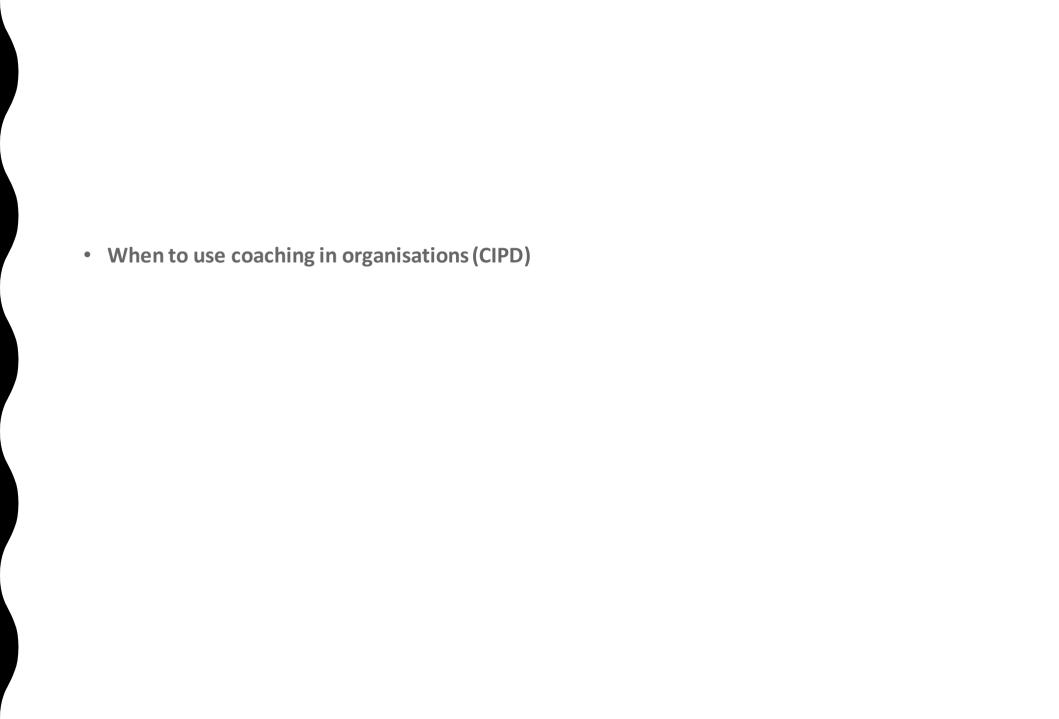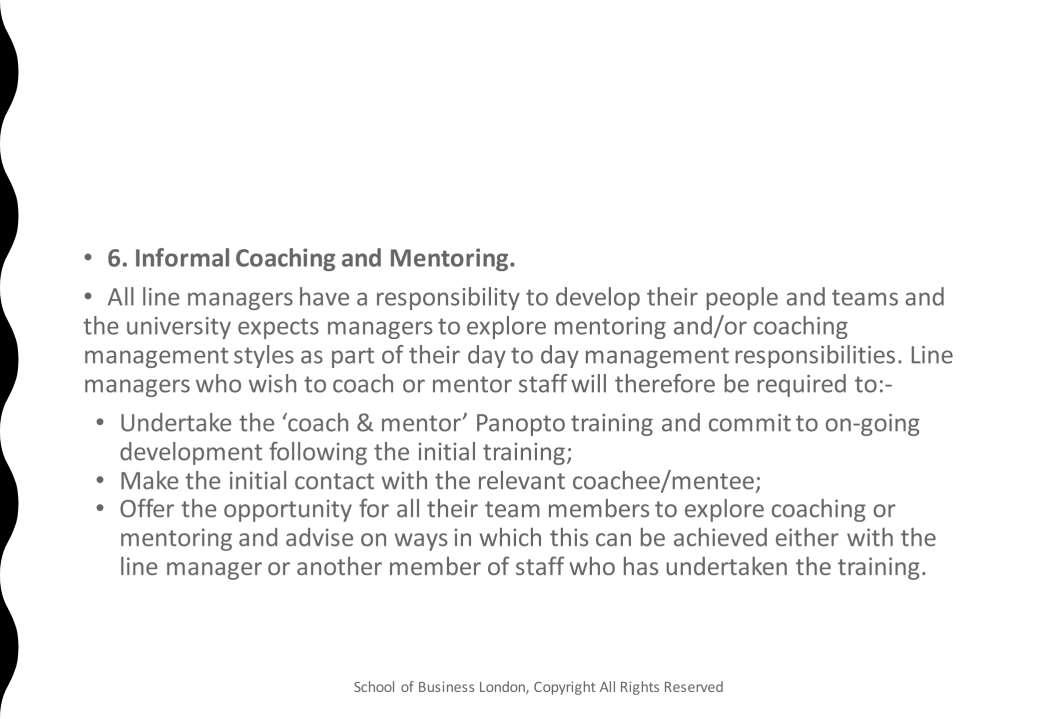Personal development
• The coaching provided by the organisation helps the employees to enhance their personal skills and increased in efficiency.
• The understanding power and working capability within the person is increased or can be increased.
• The employees become more flexible and versatile in working, and coaching will help them to create a decision making power and to understand the boundaries with improved issue resolving strategy. Western (2012)
Strategic Performance Management is a comprehensive approach to helping businesses achieve their goals. It begins with a company's strategic plan and goes from there all the way through to the employees who support that plan. Bernard May
In constructing a cost and benefit analysis that demonstrates the achievement of organisational strategic performance indicators, Learners may or may not be able to access relevant specific financial information. If the latter is the case it would still be appropriate for the Learner to identify ‘areas’ of cost and benefit in order that this criteria might be addressed; some examples are listed below but, where possible, these should be linked to the Learner’s own organisational setting.
School of Business and Technology London, Copyright All Rights Reserved
• Cost Benefit Analysis
• In constructing a cost and benefit analysis that demonstrates the achievement of organisational strategic performance indicators, Learners may or may not be able to access relevant specific financial information. If the latter is the case it would still be appropriate for the Learner to identify ‘areas’ of cost and benefit in order that this criteria might be addressed; some examples are listed below but, where possible, these should be linked to the Learner’s own organisational setting.
• Costs:
• • Staff time (coaches, mentors, coachees, mentees) including staff cover for coaching and mentoring activities and supervision of coaches and mentors; lost ‘opportunity cost’ e.g. loss of chargeable time whilst participating in coaching and mentoring activity
School of Business and Technology London, Copyright All Rights Reserved
• • Cost of training, qualifications, accreditations

• • Administration and management time for the initiative
• • ‘Housekeeping’ items: stationery, accommodation etc
• • Cost of launching and publicizing/communicating the initiative Benefits: It should be borne in mind that, in actuality, establishing ‘impact’ and ‘effect’ is often a difficult causal link to demonstrate from a specific development activity, and Learners could consider how (ideally in their own organisational context), the value of coaching and mentoring would manifest in order that the ‘return on investment (ROI) or ‘return on expectations’of the coaching and mentoring programme can be measured
School of Business and Technology London, Copyright All Rights Reserved
•
• Cost and benefit analysis of coaching and mentoring
• Mentoring is the process of emerging the talents from the individuals and is used according to the way the organisation needs it.
• An organisation purely works on the economic strength of that firm, the central managers which hold the company mainly looks after the economic structure of the company.
• Employee turnover may end up to a huge loss for that organisation and to put an end to this, many of the organisations started coaching and mentoring process and this also costs expenses to the organisation.
• The organisation have to sacrifice their work time for the employees to get trained and coached, the time that is chargeable is been given free to the employees to get mentored.
• As well as the benefits it also increases the cost of the overall organisation.
• This is a huge loss for the company, as their works get overdue.
• Denmark and Podsen (2013)

School of Business Londo











School of Business and Technology London, Copyright All Rights Reserved
Analysis
Template Part 1: Costs
specific costs for each category that
be incurred for the project managers’
workshop.
as
Cost-Benefit
Example
Instructions: List
might
coaching
Add rows
you feel necessary.
School of Business and Technology London, Copyright All Rights Reserved Direct Costs Indirect Costs Development Costs Overhead Costs Compensation for Trainees
Part 2: Benefits
Instructions:
1. Define the evaluation outcomes for the project managers’ coaching workshop.
2. Explain the operational results you will measure to show the benefits of training.
3. Add rows as you feel necessary.
School of Business and Technology London, Copyright All Rights Reserved
Evaluation Outcomes Operational Results Measures
• Cost of training
• To provide the employees proper training,the expenses are very high and this is an extra charge towards the company.
• The coach and the mentors will be well qualified, so in order to bring them to provide mentoring sessions to the employees, this also costs high.

• The administrativeand managements alsoshould undergo through training once, so that the overallcompany will be aware of what is the situation of the company.
• They will be aware and will be able to handle the situations flexibly; the time initially will be high when it comes to adaption of the scenario.
• Returnon Investment (ROI) is a performance measure used to evaluate the efficiency of an investmentor compare the efficiency of a number of different investments.ROI tries to directly measure the amount of return on a particular investment, relative to the investment's cost.19
• Return of investments
• Return on Investment (ROI) is a performance measure used to evaluatethe efficiency of an investment or compare the efficiency of a number of different investments. ROI tries to directly measure the amount of return on a particularinvestment, relative to the investment's cost.
• Investments investedin coaching and mentoring session can be achieved very faster,since its effect is very high on the employees.
• As far the management is ready to invest, then the return of investments canalso be expected, through coaching and mentoring the level of the employees are improved and will result in high benefits for the company.
School of Business and Technology London, Copyright All Rights Reserved


•
• 7 Steps to Measuring ROI in Coaching Oubridge (2014)
• 1. Agree
outcomes
• Not all coaches agree desired outcomes at the beginning of a coaching engagement. However, we believe doing so in a business setting is vital to maximizing what leaders can achieve through their coaching. To agree coaching outcomes you should explore a leader’s vision for their part of the business, the challenges they face and what they need to get better at to overcome their challenges and achieve their vision. Then focus them on what they want to tackle first and get them to state this as outcomes that they will work towards achieving.
•
•
2. Make the outcomes measurable
• It is essential to identify how you will measure achievement against the coaching outcomes the coaching participant identifies. Get them to state what will be different, such as “I will be delegating more effectively”, “Individual team members will be resolving issues on their own” and “My team will be communicating better”. Help them quantify what this will mean in whatever ways seem most relevant to them. Such as time saved, reduced number of operational issues they get needlessly dragged into, fewer problems caused by poor communications, impact on other teams, impact on customers, reduction in stress. •
School of Business and Technology London, Copyright All Rights Reserved
• 3. Align with business objectives
• Go further still with making the coaching outcomes measurable. Get the coaching participant to identify which of their business goals are connected to their coaching. Help them identify how they are connected, what key performance indicators (KPIs) are relevant, and the extent to which they will be impacted.
• 4. Involve the line manager
• Arrange a three-way meeting with the leader’s line manager. Ask the coaching participant to run through the coaching outcomes they have agreed and how they will measure results. Then ask for the line manager’s view on what the participant has said. Get their input on how the participant’s coaching outcomes connect with their business objectives, and the KPIs that will be impacted.
School of Business and Technology London, Copyright All Rights Reserved
5. Review progress
Having involved the line manager at the start of a coaching engagement, you want to keep them involved. About half way through, arrange another three-way meeting, where the coaching participant discusses progress they have made towards their coaching outcomes, what they still have to do and how the line manager can help them. Again, get the line manager’s input.
6. Measure success
At the end of a coaching engagement, get the coaching participant to assess their level of success against the coaching outcomes. Get them to identify how well they have done against the measures they agreed. And then have a final three-way meeting, involving their line manager, to get their view on the participant’s success. Facilitate a performance review discussion, where the coaching participant and the line manager agree what the participant has achieved. Get them to identify qualitative and quantitative measures, linking to the participant’s business objectives and KPIs, where possible
School of Business and Technology London, Copyright All Rights Reserved
•
7. Share results
• Once you have measured the results of your coaching write up a report. With coaching participant and line manager permission, share the report with key stakeholders in the coaching, such as the line manager’s line manager, the budget holder who paid for the coaching, the decision maker on whether to pay for more coaching and human resources.
• • • • School of Business and Technology London, Copyright All Rights Reserved
LO2: Understandingthe impact of organisational culture on coaching and mentoring
Assessment Criteria
1. Determine how organisational culture can impact on coaching
2. Determine how organisational culture can impact on mentoring
3. Evaluate the current cultural influences that may inhibit coaching
4. Evaluate the current cultural influences that may inhibit mentoring
5. Evaluate the current cultural influences that may support coaching
6. Evaluate the current cultural influences that may support mentoring
School of Business and Technology London, Copyright All Rights Reserved
• Resources , Reference BOOKS
• 1 ANDERSON, V., RAYNER, C. and SCHYNS, B. (2009) Coaching at the sharp end: the role of line managers in coaching at work. London: Chartered Institute of Personnel and Development. Available at: http://www.cipd.co.uk/hr-resources/database-search.asp
• 2 BEEVERS, K. and REA, A. (2016) Learning and development practice in the workplace. 3rd ed. London: Chartered Institute of Personnel and Development.
• 3 BLAKEY, J. and DAY,I. (2012) Challenging coaching: going beyond traditional coaching to face the FACTS.London: Nicholas Brealey Publishing.
• 4 CLUTTERBUCK, D. (2014) Everyoneneeds a mentor. 5th ed. London: Chartered Institute of Personnel and Development.
• 5 CLUTTERBUCK, D., MEGGINSON, D. and BAJER, A. (2016) Building and sustaining a coaching culture. London: Chartered Institute of Personnel and Development.
School of Business and Technology London, Copyright All Rights Reserved

13 KNIGHTS, A. and POPPLETON,A. (2008) Developing coaching capability in organisations. London: CIPD.Available at: http://www.cipd.co.uk/hr-resources/database-search.aspx
14 PARSLOE, E. and LEEDHAM, M. (2009)Coaching and mentoring: practicalconversations to improve learning. 2nd ed. London: Kogan Page.
15 PELTIER, B. (2010)The psychology of executive coaching: theory and application. 2nd ed. Hove: Routledge.
16 WHITMORE, J. (2009)Coaching for performance: growing human potential and purpose – the principles and practiceof coaching and leadership. 4th ed. London: Nicholas Brealey Publishing.
School of Business and Technology London, Copyright All Rights Reserved
• Definitions of Culture
• The unwritten beliefs, attitudes, values and expectations about how people work within the organisation ‘the way we do things around here’ Deal & Kennedy 1982
• ‘a body of learned behaviour, a collection of beliefs, habits and traditions, shared by a group of people and learned by people….’ Hofstede 1984
• ‘the collective programming of the mind’ Hofstede 1884
• “new recruits to an organisation learn the culture and must partially accept it or reject it and leave It is a powerful force which moulds and shapes behaviour of individuals but it is highly subjective and difficult to write down”
• The term ‘culture’ needs to define prior to defining the term ‘organisational culture’. Culture is a set of values and beliefs that are usually upheld and followed by members of a community. Alvesson and Sveningsson (2015)
• Organisational culture could in the form of common code of conduct, perceptions, morality, ideas, preference and values. These values and beliefs are applicable in the organisational context that can be described as organisational culture. Driskill (2018)
• The beliefs and values followed and upheld by the members including employees can be described as organisational culture. The behaviour of the members can be guided by an outstanding organisational culture. Organisational culture has the ability to knit the entire process of an organisation. Alvesson and Sveningsson (2015)
• In the organisational setting, culture consists of common norms, philosophies, attitudes, values, beliefs, ideologies, expectations and assumptions. Driskill (2018)
School of Business and Technology London, Copyright All Rights Reserved
• Coaching and Mentoring Culture
• Clutterbuck and Megginson, in 'Making coaching work: creatinga coaching culture', define a coachingculture as one where: Coachingis a predominant style of managingand working together,and where a commitment to grow the organisationis embedded in a parallel commitment to growthe people in the organisation.
• A key recommendationfor mentoringschemes is that the relationships should be 'off-line' and cross functional (Clutterbuck & Megginson, 2005) and it is reasonable to assume that this recommendation should stand for internal coaching arrangements. ...
• .. Thus, the coach should make sure that the three-party contract is reasonablyclear,agreed to by all, and sufficiently open, with objectives and deadlines not too narrowly defined. These initial steps suggest that the coach should encourage the organization to develop a coachingculture (Megginson and Clutterbuck, 2006), an environment in which coachingis embedded into the organization as an HR tool, rather than a short-term solution, engaging people both formally and informally, with col- leagues across functions and levels. As Megginson and Clutterbuck (2006) put it, Coaching… [should be] so seamlessly built into the structure of HR systems that [it occurs] automatically....
School of Business and Technology London, Copyright All Rights Reserved
• ... These initial steps suggest that the coach should encourage the organization to develop a coaching culture (Megginson and Clutterbuck, 2006), an environment in which coaching is embedded into the organization as an HR tool, rather than a short-term solution, engaging people both formally and informally, with col- leagues across functions and levels. As Megginson and Clutterbuck (2006) put it, Coaching … [should be] so seamlessly built into the structure of HR systems that [it occurs] automatically. The skills of learning dialogue are sufficiently widespread that people are able to raise difficult or controversial issues, knowing that their motivations will be respected and that colleagues will see it as an opportunity to improve, either personally, or organisationally, or both. ...

School of Business and Technology London, Copyright All Rights Reserved
• 10 Principles of OrganizationalCulture
• KATZENBACH, OELSCHLEGEL, THOMAS (2016)
• Work with and within your current culturalsituations.
• Change behaviours,and mind-sets will follow
• Focus on a critical few behaviours.
• Deploy your authentic informal leaders.
• Don’t let your formal leaders off the hook.
• Link behaviours to business objectives.
• Demonstrateimpact quickly
• Use cross-organizationalmethods to go viral.
• Align programmaticefforts with behaviours.
• Actively manage your cultural situation over time
School of Business and Technology London, Copyright All Rights Reserved
• •
• Impact
of organisational culture on coaching
• The coaching culture of an organisation expands the scope and impact of the overall structure of an organisation.
• Its impacts on the employees by boosting from top to bottom and creatively.
• The organisation decides to coach employees to achieve peak performance.
• After providing coaching for employees, the organisation achieves the following things:
• Development of leadership pipeline


• Employee engagement
• Employee Retention at every level

• Development of skills at every level
• Increase in overall business performance
• The key factors for achieving positive results in business are:
• Knowledge Management
• Optimal people performance
• A robust and aligned strategy
School of Business and Technology London, Copyright All Rights Reserved
• Importance of organisationalculture
• The various aspects which emphasise the importance of an organisation’sculture are:
• It helps in developing and promoting active and healthy relationships among the employees in the workplace.
• The culture of an organisation unites employees from different backgrounds
• It symbolises specific guidelines which help in guiding the employees and provide logical direction at the workplace.
• It is the standard which decides the method used by employees to communicate among the team in the workplace.
• Organisationspossess the same culture and the way to maintaining and depicts organisation standard.
School of Business and Technology London, Copyright All Rights Reserved
Four Cultural Norms Support Constructive Cultures


• Affiliative
• The affiliative norms provide sensitive, cooperativeand friendly satisfaction for work groups of an organisation.
• The affiliative norms are enhanced by the following ways:
• The way of connection and cooperation between team members
• The level of satisfaction of members in a work groups
• The changethat can be made in a team
• Pundt and Herrmann (2015)
• Achievement
• The coachingprocess of an organisationconcentrates on achievement-related norms as it mainly focuses on the SMART goal setting.
• The SMART goals will help the leaders to become active role models and achieve and set goals for the broader development of the organisation.
• For encouragingachievement norms coaches consider various aspects and are:
• The maximum involvement of team members in settingup their own goals
• Actions and clear strategies supportthe developed goals
• The close connection of organisationalpriorities and goals with individual development goals
• The regularity in collecting feedback based on the progress for achieving the developed goals of an organisation
• Coaches help the leaders to overcome current weaknesses and issues and work for the development of the organisation.
School of Business and Technology London, Copyright All Rights Reserved
Humanistic-Encouraging
• The coaching helps leaders of the organisation to understandthe influences of different mentalmodels.
• The mental models are considered as the underlying patternsof perceptions, emotions and thoughts which direct the actions and behaviour.
• Mental models will support, drive and serve the leader and can enter into the path of leaders and miss opportunities.
• It helps leaders to re-frame, understand, challenge and examine mental models.
• The various aspects considered for humanistic-encouraging are:
• The support level received for the leader in fulfilling his role
• The level of comfort of leaders in expressingthe suggestions and ideas
• The fact which permits leaders to express their ideas and suggestions
• How the small change made by leaders bring a significant impact in improvising the sincerity among team
• Lessons Learned
• Learned about an organisational culture and various aspects related to it

• Understood the various impacts of organisational culture on coaching
• Studied briefly about the several impacts created by organisational culture on mentoring
• Learned about the important cultural influences in the current period that may hinder coaching
• Learned in deeply about the cultural influences in the current period that may hinder mentoring
• Studied about the existing positive cultural influences on coaching
• Understood about the existing positive cultural influences on mentoring

School of Business and Technology London, Copyright All Rights Reserved
• Cultural web model Mossop et al. (2013)
• In 1992, the cultural web model was introduced by Kevan Scholes and Gerry Johnson.
• Using the cultural web model, an organisation can analyse the prevailing culture. After the analysis, changes can be made if required to build a better culture.
• Cultural practices and assumptions can be unveiled using this model. Mossop et al. (2013)
• Stories
• Rituals and Routines
• Symbols
• Organisational Structure
• Control Systems
• Power Structures
• Geert Hofstede 1983
• Dimensions of National Culture
• Organisational culture is strongly influenced by national ‘mores’.
• Mores Definition ‘Customs or conventions regarded as essential to or characteristic of a community’.
• American companies different from Japanese, British companies different from Continental ones
School of Business and Technology London, Copyright All Rights Reserved
• OrganisationalCulture & Nationality
• “……..collective mental programming;it is that part of our conditioning that we share with other members of our nation, region or group but not with members of other nations, regions or groups.”
Hofstede, 1983
•
• Hofstede’sSix Dimensions
• Six dimensions of national culture which measures the differences in peoples work related values
• Power distance index (PDI)
• Individualism vs. collectivism (IDV)
• Uncertainty avoidance (UAI)
• Masculinity vs. femininity (MAS)
• Long-term orientation vs. short-term orientation (LTO)
• Indulgence vs. restraint (IND)
School of Business and Technology London, Copyright All Rights Reserved
An inclusive society, openness to change and innovation are the key characteristics of low UAI society. If a society is long term oriented, education, obligations and virtues are emphasised. Strong convictions can be seen in a short term orientedsociety. Minkov and Hofstede (2012)
In the high MAS society, strong ego, money and accomplishments are given priority. Relationship oriented society and emphasis on quality of life are the important features of low MAS society. A society will be structured, rigid and conservative if the UAI is high. Migliore (2011)
An inclusive society, openness to change and innovation are the key characteristics of low UAI society. If a society is long term oriented, education, obligations and virtues are emphasised. Strong convictions can be seen in a short term orientedsociety. Minkov and Hofstede (2012) Freedom of speech, optimism and personal happiness could be seen in a high indulgence society. In a high restraint society, rigid and regulatedbehaviourand pessimism can be seen. Cronjé (2011)
School of Business and Technology London, Copyright All Rights Reserved
• Individualism versus collectivism
• Refers to the relation between an individual and their fellow individuals.
• In more individualistic societies everyone is supposed to look after their own self-interest and maybe, there close family.
• In a collectivistsociety, links between individuals are very tight. People are born into in-groups and are supposed to look after the in-groups interests.
• The degree of individualism is related to a country’s wealth.
• High correlation between low income and low individualism.( Pakistan, Peru, Portugal)
• Opposite end of the scale - USA, Canada, Denmark being individualistic
• UK has a high individualism index
• Germany has higher income but much lower individualism than the UK
•
School of Business and Technology London, Copyright All Rights Reserved
Power distance

• Concerned with society’s reaction to inequality. Some societies all inequalities in power and wealth to grow, others try to reduce them as much as possible.
• In organisations the level of power distance is related to the degree of centralisation of authority and the degree of autocratic leadership
• Power distance relates to how people relate to their superiors and subordinates. Where power distance is high superiors are far less accessible to subordinates than where power distance is low.
• India, France, Belgium has a large power distance

• UK, USA, Australia have a small power distance combined with high individualism
• All poor countries are collectivist with large power distance
School of Business and Technology London, Copyright All Rights Reserved
Uncertainty avoidance

Concerns attitude to risk.
• Weak uncertainty avoidance communities
• Take risks easily, are more tolerant of behaviour and opinions different from their own, feel relatively secure
• Strong Uncertainty avoidancecommunities
• Show higher levels of anxiety and emotionality, create institutions to create security, have laws and rules which imply little tolerance of abnormal behaviour and opinions, have faith in technology and religions that claim absolutetruth
• Japan , Latin America and Latin European countries have strong uncertainty avoidance and large power distance
• The UK and Sweden combine small power distance with medium to weak uncertainty avoidance.( shared solutions, initiative)
• Asian countries have large power distance with medium to weak uncertainty avoidance.(Familymodel, with a patriarchal authority figure
School of Business and Technology London, Copyright All Rights Reserved
• Masculinity versus femininity
• Concerned with social attitudes to the division of work between the sexes. What does society consider suitable work for women? What jobs should be offered to men?
• UK during there has been a considerable shift in opinion and attitudes. Equal Opportunities Commission cases by men, secretarial, domestic, nursing roles.
• In the UK , no gender bias.
• Japan, Germany, Austria , Switzerland are highly masculine.
• UK, India and the USA more moderate
• Scandinavians most feminine
School of Business and Technology London, Copyright All Rights Reserved
• Indulgence Versus Restraint
•
• Hofstede's sixth dimension, discovered and described together with Michael Minkov, is also relatively new, and is therefore accompanied by less data.
•
• Countries with a high IVR score allow or encourage relativelyfree gratification of people's own drives and emotions, such as enjoyinglife and having fun.
• In a society with a low IVR score, there is more emphasis on suppressing gratification and more regulation of people's conduct and behaviour, and there are stricter social norms.
• Charles Handy 4 Types of Corporate Culture
• The Power Culture
• influence & authority from a single source
• The Role Culture
• bureaucracy, rules, status = authority,
• The Task Culture
• focus on task, expertise,teams & matrix
• The Existential/Person Culture
• Individuals pursuing personal goals
• https://www.trainingzone.co.uk/lead/culture/so-you-think-you-know-what-a-coaching-culture-is
School of Business and Technology London, Copyright All Rights Reserved
• Huczynskiand Buchanan Culture
• OrganizationalCulture.The simple way of explaining culture is the way of how things are done in a business. According to Huczynski and Buchanan"an organization's culture focuses on the values, beliefs and meanings used by its members to grasphow its uniqueness originates, evolves and operates".
•
• Organizational Culture
• Organizationalculture encompassesvalues and behavioursthat contributeto the unique social and psychological environment of a business. The organizationalculture influences the way people interact, the context within which knowledge is created, the resistance they will have towards certain changes, and ultimately the way they share (or the way they do not share) knowledge. Organizationalculturerepresentsthe collective values, beliefs and principles of organizationalmembers. It may also be influenced by factors such as history, type of product, market, technology, strategy, type of employees, management style, and national culture. Culture includes the organization'svision, values, norms, systems,symbols, language, assumptions, environment, location, beliefs and habits.
• http://www.businessdictionary.com/definition/organizationalculture.html
School of Business and Technology London, Copyright All Rights Reserved
• The values and behavioursthat contributeto the unique social and psychological environment of an organization.
• Organizationalculture includes an organization'sexpectations,experiences, philosophy, and values that hold it together, and is expressed in its self-image, inner workings, interactions with the outside world, and future expectations. It is based on shared attitudes, beliefs, customs, and writtenand unwrittenrules that have been developed over time and are consideredvalid. Also called corporateculture, it's shown in
• (1) the ways the organization conducts its business, treats its employees, customers, and the wider community,
• (2) the extent to which freedom is allowed in decision making, developing new ideas, and personal expression,
• (3) how power and information flow through its hierarchy,and
• (4) how committedemployees are towards collective objectives.
•
• It affects the organization'sproductivityand performance,and provides guidelines on customer care and service, product quality and safety, attendanceand punctuality, and concern for the environment.
• It also extends to production-methods,marketing and advertising practices, and to new product creation.
Organizationalculture is unique for every organization and one of the hardest things to change.
School of Business and Technology London, Copyright All Rights Reserved
• Understanding Organisational Culture
• Interest in organisational culture began in the early '80s when management gurus such as Tom Peters began to focus on culture as a differentiator of successful organisations. In the past twenty-odd years interest in culture has increased as case studies have identified a strong link between organisational culture and its performance.
• What is organisational culture?
• Organisational culture is the personality of the organisation, 'the way we do things around here'. Originally an anthropological term,culture refers to the underlying values, beliefs and codes of practice that make a business what it is.



School of Business and Technology London, Copyright All Rights Reserved
• Management psychologist Schein describes culture as a phenomenon that surrounds us all. Culture according to Schein is 'A pattern of shared basic assumptions that a group learns as it solves problems'.
• It can be seen through:
• 1. Behaviour: language, customs, traditions
• 2. Groups norms: standards and values
• 3. Espoused values: published, publicly announced values
• 4. Formal Philosophy: mission
• 5. Rules of the Game: rules to all in organizations
• 6. Climate: climate of group in interaction
• 7. Embedded skills
• 8. Habits of thinking, acting, paradigms: Shared knowledge for socialization
• 9. Shared meanings of the group
• 10. Metaphors or symbols
School of Business and Technology London, Copyright All Rights Reserved
Influences on Culture
• The culture of an organisation is influenced and shaped by
• National mores
• The environmentof the organisation
• The nature and purpose of the organisation
• The history and stage of development
• The values and beliefs of the people
• The management style The structure of the organisation
School of Business and Technology London, Copyright All Rights Reserved
• Why is culture important?
• Evidence shows that organisations who have strong cultures are capable of increasing revenue, profitability and shareholder value. Likewise organisations with weak cultures find it difficult to change and adapt to market demands. Many ex-monopolies in the public sector for example struggled to respond to changing consumer patterns. In the early 1990s IBM recognised that it needed to fundamentally change its culture and self-belief that it was invincible in the marketplace. Its then somewhat arrogant culture had prevented it from recognising the rise in demand for personal computers and it was in danger of failure as a company.

• With the growing increase in globalisation, organisations facefar more competition than ever before. Having a strong culture which supports and underpins an organisation's brand proposition helps businesses create and maintain competitive advantage - witness organisations such as Sony, Disney and Orange.
• Increasingly business leaders are recognising that the concept of organisationalculture is particularly important when it comes to managing organisation-wide change. If change is to be deep seated and long lasting within an organisation, it needs to happen at a cultural level. The challenge for many organisations is how to change existing cultures as culture is rooted deep in the unconscious but represented in behaviour and practice
School of Business and Technology London, Copyright All Rights Reserved
• Different types of culture
• The best way to begin a culture change process is to better understand the culture in which you are currently operating. If you don't understand and manage culture, it will manage you.
• There are a number of different types of culture, just like there are many different personalities. Here is a selection of theories of culture types:
• Charles Handy points out that there are three cultural types:
• Power cultures with a single power source. This may be an individual ora group who typically controls via a web of communications how people are rewarded.
• Task cultures based on flexible matrix structures preserve a strong sense of purpose and promote teamwork.
• Role cultures which predominate typically pyramid structures and where hierarchy and regulation abound.
School of Business and Technology London, Copyright All Rights Reserved
• Jeffrey Sonnenfeld identified the following four cultural types:
• • Academy culture typified by stable environments such as hospitals, universities, large corporationswhere employees are highly skilled and tend to stay with the organisation.
• • Club culture typified by military organisations where employees work their way up the organisation. There is a strongsense of fit with the group and organisations promote from within, valuing seniority
• • Fortress culture where specialised skills are promoted and where organisations respond to marketneeds by downsizingor reorganising for example in financial services and car manufacturers
• • Baseball team culture where employees are 'stars' with skills that allow them to readily transfer from one firm to another e.g. advertising agencies, investment banking
• In his book, The Chameleon Consultant (Gower Publishing2002 ISBN 0 566 08407 4), Andrew Holmes develops a model of four generic types of culture:
• • High Sociability, LowSolidarity = Networked culture
• • High Sociability, HIgh Solidarity = Communal culture
• • Low Sociability, LowSolidarity = Fragmented culture
• • Low Sociability, High Solidarity = Mercenary culture
School of Business and Technology London, Copyright All Rights Reserved
• Methods for analysing organisational culture, Johnson and Scholes Cultural Web
• One way to understand culture is to use an analytical framework. Johnson and Scholes call their framework the Culture Web, a series of overlapping aspects of culture which make up the collective mind-set. The Culture Web is best considered individually and then discussed with groups of managers. For example, look at your own organization in relation to the following:
• Symbols - logos, offices, cars
• Power - who has power
• Organizational Structure - formal and informal structures
• Controls - what gets measured and rewarded
• Rituals - what are accepted procedures and rituals
• Stories - sometimes called 'war stories'
School of Business and Technology London, Copyright All Rights Reserved
• Changing Culture
• There is a growing trend as identified above for culture change to be promoted to bring about greater organisationaleffectiveness. Most management gurus recognise that changing culture is a long-term project. It takes between three and five years. It is a process that can be undertaken bottom up but ultimately very much depends on the leadership of the organisation. This group shapes and reinforces the way that the organisation functions.
• Itis generally accepted that to bring about culture change, all aspects of the organisation need to change.
• Mckinsey 7 'S' framework
• The 7 'S's diagnostic framework, developed by management consultants McKinsey, provides a useful perspectivewith which to assess the culture and effectiveness ofan organization. The Seven 'S's are:
• 1 Structure
• 2 Strategy
• 3 Shared values
• 4 Style
• 5 Staff
• 6 Skills
• 7 Systems
School of Business and Technology London, Copyright All Rights Reserved
• 1. Structure
• There are many permutations of structure that an organization can adopt:
• • Centralised
• • Decentralised

• • Hierarchical
• • Flat
• • Team based
• • Virtual
• Each has its pros and cons. For example many layers of hierarchy can block a leader's access to customers and vice versa. Middle managers may 'filter' reality and present leaders with the picture of customer satisfaction which they wish them to see. The result of this is not only leaders who lack customer focus, but also employees who are fearful of 'stepping out of line' or taking responsibility for the customer.
School of Business and Technology London, Copyright All Rights Reserved
2. Strategy
The strategy of an organizationshapes its structure. Likewise the behaviours and values of an organization can promote or undermine its strategy
3. Shared values
If you discover the passion of the CEO, you will discover the organizations real priorities. Is there fundamentalpassion towards – making money?- staff relationships?- customer orientation?
These are important issues to get to the bottom of. What measures are used in reward systems?This often shows the reality of what is important to the organization


Senior managers can all too easily become cocoonedin a world far removed from the customer and the company people who work at the sharp end. One acid test of how removed your senior people may be from customers is: Who replies when a customer writes to the CEO?
This remoteness frequently leads managers to:
• Becomehooked into the internal politics of the organization
• Shut off from honest feedback
• Rarely see the customer face-to-face
This can all add up to management decisions which are far from customerfriendly such as rules and regulations that work well for the organization but not the customer.
•
•
4. Staff
• We are increasingly engaged within organizations to move front-line employees from a dependent, compliant and rule-bound style towards one where they freely take risks and confidently exercisediscretion. The answer frequently starts with the very senior managers who bemoanthe lack of initiative in their staff. People working for 'task-master' style managers who are directive and autocratic develop into terrorists - reluctant or resistant to change, or spectators - who take a back seat when it comes to resolving a customer problem. This is because people often become resentful or discouraged to take initiative when they are constantly told what to do and when the only feedbackthey receive is negative.
• New recruits soak up culture like sponges: they may have been recruited for their winning qualities, but they are influenced strongly by other's behaviours.
•
6. Skills
• Customer orientated organizations such as the department store Nordstrom in the US emphasize the attitude and interpersonal skills needed to interact effectively with customers. Role, skills and knowledge can be taught, whereas many of the less tangible, empathetic interpersonalskills involve being able to create vital rapport with customers. Nordstrom recruit only self-starters - a high commission system helps deselect others. Each of Nordstrom's 35,000 staff effectively runs their own business (within limited rules).
School of Business and Technology London, Copyright All Rights Reserved
7. Systems
The systems, which organizations use to interact with their customers, need to be designed with the customer in mind.
Conclusions
• Organisational culture is the glue that holds the organisation together.
• Culture is important as a strong culture has proven to underpin high performance
• There are many different types of culture which can exist even within the same organisation
• Questionnaires, audits, card sort techniques and rich pictures are methods for diagnosing organisational culture
• Changing organisationalculture requires a long term approach ? it involves reassessing and making changes to all aspects of the organisation
Sarah Cook, Stairway Consultancy Ltd, www.thestairway.co.uk (2019)
• Organisational culture Characteristics
• Stability
• Innovation
• Teamwork
• Attention to detail
• Aggressiveness
• Emphasis on outcome and people
• Alvesson and Sveningsson (2015)
• What is

Coaching Culture Parsloe
(2016)
• In a coaching culture, most staff use a coaching approach in their daily life – with each another, and with external stakeholders and customers. A true coaching culture is just ‘part of the way we do things around here’. But it’s not all motherhood and appl e pie. A coaching culture is about delivering results, improving performance and making the most of people’s potential. The emphasis is on del ivering results and making each other (and the wider organisation) stronger and more capable. It’s NOT about having coaching conversations for their own sake, or as a diversion from other activities!
• If you could be a ‘fly on the wall’ in a coaching culture, here’s what you’d see:
•
School of Business Londo
• Managers looking for opportunities to help others to learn
• People asking each other open questions
• Employees at all levels having open, honest and supportive conversationswith one another
• People routinely giving one another feedback - supportive and critical
• Managers coaching team members to help them develop, rather than just to tackle poor performance
• Coaching and mentoring relationships forming spontaneously
• Senior leaders with a clear vision that coaching and mentoring are at the heart of how we operate
• Teams working with clear goals, roles, processes and relationships
• Relatively few people will be ‘playing politics’
• A pragmatic focus on delivering results and at the same time building the long-term health of the business Parsloe (2016)
https://www.koganpage.com/article/what-is-a-coaching-culture
School of Business and Technology London, Copyright All Rights Reserved
• Creating a Coaching Culture CIPD
• • What is the organisation's strategy?
• • How does the organisation position itself?
• • What priorities does the organisation have?
• • Who supports coaching and mentoring?
• Coaching Culture
• A coaching culture simply means supporting your employees so that they learn new skills and become greater assets to the company. A management culture that emphasizes training, regular feedback, and opportunities for growth creates a more engaged and energized workforce.
• The benefits of a coaching culture. ... Coaching in the workplace improves leadership development. It also improves employee engagement, communication skills and teamwork in the company.
Businesses that value the importance of coaching have seen significant results in employee engagement and financial productivity.
School of Business and Technology London, Copyright All Rights Reserved
• What is a Coaching Culture? Parsloe (2016)
• If you could be a ‘fly on the wall’ in a coaching culture, here’s what you’d see:
• Managers looking for opportunities to help others to learn
• People asking each other open questions
• Employees at all levels having open, honest and supportive conversationswith one another
• People routinely giving one another feedback - supportiveand critical
• Managers coaching team members to help them develop, rather than just to tackle poor performance
• Coaching and mentoring relationships forming spontaneously
• Senior leaders with a clear vision that coaching and mentoring are at the heart of how we operate
• Teams working with clear goals, roles, processes and relationships
• Relatively few people will be ‘playing politics’
• A pragmaticfocus on deliveringresults and at the same time building the long-term healthof the business
• How to createa “coachingculture” Parsloe (2016)
• The first step is to create clear vision for the culture. It doesn’t have to be a perfect picture but it does need to be inspiring! How will the culture help you deliver the strategy? What’s in it for leaders –and for all employees? How will it benefit your customers/ shareholders?
• It’s also important to know where you’re coming from. You can conduct a ‘readiness audit’ to find out how much coaching and mentoring are already happening in your organisation. And how receptive people are to doing things differently.
• And it’s important to have some first steps. In the early stages of creatinga coaching culture, there’s often more reliance on external coaches and external support. But this reliance soon drops away as you train a cohort of internal coaches and/or mentors –as well as leaders who use a coaching approach in their daily lives. This trickles down to how employees treat each other.
• Creating a coaching culture takes time but doesn’t always take a lot of investmentif it’s done in a savvy way. Parsloe (2016) https://www.koganpage.com/article/what-is-acoaching-culture
School of Business and Technology London, Copyright All Rights Reserved
• Creating a Coaching Culture Bishop (2018)
• “Creating a coaching culture at work has several benefits for you and your employees. Staffare given development opportunities and therefore likely to feel more valued and motivated. In turn, the business can mitigate the risk of high staff turnover and save money on recruitment by encouraging progression and promoting from within” Bishop (2018)
• Top employee desires in the workplace are:
• To feel appreciatedand valued
• To gain a deeper understanding of their role in the business
• To feel a deeper social connection to their colleagues
• To achieve a greater work life balance
• The top benefits to a vibrant and constantly evolving coaching culture in the workplace are:
• Improving employees sense of purpose
• Boosting morale and employee motivation
• Increasing productivity through skill development
• Improving internal communication and rapport across the business
• Improving employee engagement
• Improving employee wellbeing
• Reducing the need to recruit externallyfor senior roles
• Reducing employee turnover
School of Business and Technology London, Copyright All Rights Reserved
• Schein Definition of Culture
• Schein describes two very different organisations:
• Organisation A
• Operates on the assumption that:
• •
Ideas comes ultimately from individuals
People are responsible, motivated and capable of governing themselves
• •
• • Nevertheless,in practice, truth can only be arrived at by fighting things out in groups
• • Such fighting is possible because members of the organisationsee themselves as a family who will take care of each other.
• It is therefore safe to fight and be competitive
• Characteristics: •
Open office landscapes
Few closed doors
People milling about
Intense organisations and arguments
A general air of informality
School of Business and Technology London, Copyright All Rights Reserved
•
• • • • • • •
•
•
• Organisation B
• Operates on the assumption that: •
Truth comes ultimately from older, wiser and higher status members
People are capable of loyalty and discipline in carrying out directions
Relationships are basically lineal and vertical
Each person has a niche in the organisation that cannot be invaded
The organisation is responsible for taking care of its members.
Characteristics:
Hush in the air
Everyone in an office with closed doors
Nothing is done except by appointment and prearranged agenda
If people of different ranks are present there is real deference and obedience
• •
• •
An air of formality permeates everything
School of Business and Technology London, Copyright All Rights Reserved
• • •
•
•
•
•
•
•
•
•
• • •
• •
• Neither organisation is wrong – they are just different .From Schein, “Coming to a New Awareness of Organisational Culture”, Sloan Management Review, (1984)
• On the Coevolution of Stereotype, Culture, and Social Relationships: An Agent-Based Model
• Kenneth Joseph, Geoffrey P. Morgan, Michael K. Martin , Kathleen M. Carley (2014)
• Constructuralism
• The theory of constructuralism describes how shared knowledge, representative of cultural forms, develops between individuals through social interaction.
• Constructuralism argues that through interaction and individual learning, the social network (who interacts with whom) and the knowledge network (who knows what) coevolve. In the present work, we extend the theory of constructuralism and implement this extension in an agentbased model (ABM).
School of Business and Technology London, Copyright All Rights Reserved

https://pdfs.semanticscholar.org/e91b/8eaca0b540b de7874590b6c0b68b82270140.pdf?_ga=2.34126561.1 31983155.1579171737-2010265328.1579171737
• Learning Outcome Three
• Understand how coaching and mentoring can impact the organisation
• AC 3.1 Discuss the use of coaching to contribute towards performance management
• AC 3.2 Discuss the use of mentoring to contribute towards performance management
• AC 3.3Determine the need for board level endorsement of coaching
• AC 3.4 Determine the need for board level endorsement mentoring
• AC 3.5 Determine how coaching can support a range of development issues
• AC 3.6 Determine how mentoring can support a range of development issues
• AC 3.7 Evaluate the effect of coaching on organisational culture
• AC 3.8 Evaluate the effect of mentoring on organisational culture
School of Business and Technology London, Copyright All Rights Reserved
• Resources, Reference BOOKS
• 1 ANDERSON, V., RAYNER, C. and SCHYNS, B. (2009) Coaching at the sharp end: the role of line managers in coaching at work. London: Chartered Institute of Personnel and Development. Available at: http://www.cipd.co.uk/hr-resources/database-search.asp
• 2 BEEVERS, K. and REA, A. (2016) Learning and development practice in the workplace. 3rd ed. London: Chartered Institute of Personnel and Development.
• 3 BLAKEY, J. and DAY,I. (2012) Challenging coaching: going beyond traditional coaching to facethe FACTS. London: Nicholas Brealey Publishing.
• 4 CLUTTERBUCK, D. (2014) Everyone needs a mentor. 5th ed. London: Chartered Institute of Personnel and Development.
• 5 CLUTTERBUCK, D., MEGGINSON, D. and BAJER, A. (2016) Building and sustaining a coaching culture. London: Chartered Institute of Personnel and Development.
• 6 CONNOR, M.P. and POKORA, J.B. (2012) Coaching and mentoring at work: developing effective practice. 2nd ed. Maidenhead: Open University Press.
• 7 COX, E. (2013) Coaching understood: a pragmatic enquiry into the coaching process. London: Sage Publications.
• 8 COX, E., BACHKIROVA, T.and CLUTTERBUCK, D.A. (2014) The complete handbook of coaching. 2nd ed. London: Sage Publications.
• 9 DOWNEY, M. (2014) Effective modern coaching:the principles and art of successful business coaching. London: LID Publishing.
• 10 FLAHERTY, J. (2010) Coaching: evoking excellence in others. 3rd ed. Abingdon: Routledge.
Copyright All
School
Rights
of Business and Technology London,
Reserved
3.1 & 3.2 these criterionshare many of the aspects covered in LO1 above.A specific recognition of the need to explicitly embed coaching and mentoring as part of the organisational architectureand strategies around performance management is relevant to these criteria
3.5 & 3.6 Linking to AC 3.1, 3.2, 3.3 & 3.4 and thus the content proposedabove, a worked example could relate to: • Continuous Professional Development and the notionof the ‘learning organisation’.An appetite on the part of the individual and, institutionally, to create opportunities forlifelong learning and organisational development is well-served by the coaching and mentoring process due to its pervasive, embedded andenduring characteristics. An established coaching and mentoring culture can change the way the organisation provides development andhow it addresses issues relating to development

School of Business Londo
• Define Coaching
• Coach: From the Middle English expression “coche”: A secure means of conveyance from one location to another
• Products of Coaching: Self generating, self-correcting, long term excellent performance.
(Flaherty: Evoking Excellence in Others 1999)
• “Coaching is a process, trust the process…” Eric
Parsloe
• "Coaching is unlocking a person’s potential to maximise their own performance. It is helping them learn rather than teaching them"
J. Whitmore 2004
• Coaching is "a process that enables learning and development to occur and thus performance to improve. To be successful, a coach requires a knowledge and understanding
School of Business and Technology London, Copyright All Rights Reserved
• of process as well as the variety of styles, skills and techniques that are appropriate to the context in which coachingtakes place"
-- Eric Parsloe 1999

• "Partnering with clients in a thought-provoking and creativeprocess that inspires them to maximizetheir personal and professional potential” Myles Downey- 2003
• A collaborative, solution focused, result-orientated and systematic process in which the coach facilitates the enhancement of work performance, lifeexperience, self-directed learning and person growth of the coachee"Whitmore- 1992
• “Coaching is a method that intends to advance achievement and concentrates on the here and now rather than on the far away past or future. While there are several distinct models of coaching, here they are not considering the coach as an expert but, alternatively, the coach as a facilitator of learning. There is a massive contrast among training someone and supporting them to learn”. Ely et al. (2010)
• “Employees are more engaged with their work when they are able to do what they do best.” Adapted from Buckingham & Coffman 1999 First Break all the Rules
• Psychology of Coaching “…concernedwith making explicit and transparent those psychological theories, models and approaches that are used within coaching in order to facilitate learning and change more effectively” Chapman 2004
School of Business Londo
• Define Mentoring
• "Off-line help from one person to another in making significant transitions in knowledge, work or thinking" Megginson and Clutterbuck-1995
• “Mentoringis a long term relationship thatmeets a development need, helps develop full potential, and benefitsall partners, mentor,mentee and the organisation”- Suzanne Faure
• “Mentoring involves primarily listening with empathy, sharing experience (usually mutually), professional friendship, developing insight through reflection, being a sounding board, encouraging”- David Clutterbuck 1995
• “Mentoringis an importantadult relationship since it creates a legitimate and special space where people can take chances b y trying to be authentic about, and find meaning within their real-life professional experience” - D Doyon
• “Mentoringis a supportive learning relationship between a caring individual who shares knowledge, experience and wisdom with another individual who is ready and willing to benefit from this exchange, to enrich their professional journey”. - Suzanne Faure
• "Mentoringis a protected relationship in which learning and experimentation can occur, potential skills can be developed, and in which results can be measured in terms of competencies gained". Suzanne Faure
School of Business and Technology London, Copyright All Rights Reserved
•
What is coaching? CIPD
• Coaching aims to produce optimal performance and improvement at work. It focuses on specific skills and goals, although it may also have an impact on an individual’s personal attributes such as social interaction or confidence. The process typically lasts for a defined period of time or forms the basis of an on-going management style. Although there's a lack of agreement among coaching professionals about precise definitions, there are some generally agreed characteristics of coaching in organisations:
• It's essentially a non-directive form of development.
• It focuses on improving performance and developing an individual.
• Personal factors may be included but the emphasis is on performance at work.
• Coaching activities have both organisational and individual goals.
• It provides people with the opportunity to better assess their strengths as well as their development areas.
• It's a skilled activity, which should be delivered by people who are trained to do so. This can be line managers and others trained in coaching skills.
School of Business and Technology London, Copyright All Rights Reserved
• What is mentoring? CIPD
• Mentoring in the workplace tends to describe a relationship in which a more experienced colleague shares their greater knowledge to support the development of an inexperienced member of staff. It calls on the skills of questioning, listening, clarifying and reframing that are also associated with coaching
• One key distinction is that mentoring relationships tend to be longer term than coaching arrangements. In a succession planning scenario, for example, a regional finance director might be mentored by a group level counterpart over a lengthy period to develop a sound approach to dealing with the board, presenting to analysts and challenging departmental budgets.
• Mentoring relationships work best when they move beyond the directive approach of a senior colleague ‘telling it how it is’, to one where they both learn from each other. An effective mentoring relationship isa learning opportunity for both parties, encouraging sharing and learning across generations and/or between roles.
School of Business and Technology London, Copyright All Rights Reserved
• The aims of workplace coaching can include:
• • assisting performance management
• • preparing and supporting people through change
• • supporting learning and development.
• Creating a Coaching Culture CIPD
• • What is the organisation's strategy?
• • How does the organisation position itself?
• • What priorities does the organisation have?
• • Who supports coaching and mentoring?
School of Business and Technology London, Copyright All Rights Reserved
•
•
What is coachingand mentoring?
• • Nowadays coaching and mentoring have been increased immensely since it helps to build the confidence and creates a positive vibe for both personal and professional development.
• •
It helps to boost the power of gaining knowledge.
Speaking in terms of organisations, coaching provides more experiences in career growth and thus they have arranged mentoring sessions to enrich the customers with lots of confidence.
• •
• • At work place, mentoring and coaching is arranged for those who have to improve the potential and achieve betterment in work, it is recommendedto receive either mentoring or coaching.
• Research Sources
• Contributors to the body of knowledge regarding coachingand mentoring include;
TGROW Model Myles Downey (2003)
Spectrum of Coaching Pull –Push Model Myles Downey (2014)
The Coaching Continuum. Hawkins, P.& Smith, N. (2006)
Dembkowski and Eldridge (2003) ACHIEVE coaching model
Somers (2006) ARROW coaching model
School of Business and Technology London, Copyright All Rights Reserved
•
• • • • • • •
•
Hawkins (2012) CLEAR coaching model
Cognitive Behavioural Coaching (CBC) Beck, (1976); Ellis, (1994)
Whitmore (1992) GROW Model
Bee and Bee (2007) RAMcoaching model
McLeod (2003) STEPPA coaching model
Nested-levels model Adapted from Weiss (2004).
Purpose, Perspectives, Process. Lane and Corrie (2006).
ACHIEVE –
• A - Assess the current situation
• C - Creatively brainstorm alternatives
• H - Hone goals
• I - Initiate options
• E - Evaluate options
• V - Validate an action program design
• E - Encourage momentum
School of Business and Technology London, Copyright All Rights Reserved • • • • • • • • • • • • • • • •
Dr. Sabine Dembkowski & Fiona Eldridge
• David Clutterbuck and David Megginson and Coaching Culture
• Six stages that lend themselves to a coachingculture.
• 1. Coaching is linked to business drivers, it is linked to high performance, strategy and processes.
• 2 Being a coachee leads to feeling supported and it is a valuable activity.
• 3. Coach training should be available to everyone, allowing them to become qualified and have suitable follow up time.
• 4. Coaching should be rewarded because it is regarded as investing in the employees who work with the manager in the team.
• 5. Have an allowancefor growth, allow everyone to share in ideas and initiatives.
• 6. Senior management and line managers promote a coaching culture, while also understanding how it supports and empowers people.
• Here is a quote from an article from Martin Bauer:
• “If you want to be a leader, how successful you are will depend greatly on the culture where you work. “But wait,” you might say, “doesn’t it matter more that you have the ability to lead? That you have the traits that make a leader?” Perhaps, but if the culture you work in doesn’t allow you to practice those traits — or worse still, discourages those traits — they become irrelevant.”
School of Business and Technology London, Copyright All Rights Reserved
• Daniel Goleman’s 6 Leadership Styles
• • Commanding Leadership Style
• • Visionary Leadership Style
• • Affiliative Leadership Style
• • Democratic Leadership Style
• • Pacesetting Leadership Style
• • Coaching Leadership Style
• Exploring and understanding coaching models
(Noel Jimbai)
• Listening and observation are key skills for the business coach. Developing the skill of observation is partly to develop the ability to be ‘inside’ the coaching conversation, and to be ‘observing’ the conversation. It is to take up a meta-position, while never leaving the micro level of being present for the client (Stout-Rostron, 2006c:152).
School of Business and Technology London, Copyright All Rights Reserved
Coaching models help us to understand the coaching intervention from a systems perspective, and to understand the need for “structure” in the interaction between coach and client. Models help us to develop flexibility as coach practitioners. They offer structure and an outline for both the coaching conversation and the overall coaching journey—whether it is for 20 hours, six months, a year or more. However, although models create a system within which coach and client work, it is imperative that models are not experienced as either prescriptive or rigid. The coaching conversation is about the client, not the coach. If the model is too prescriptive, it means the coach has their own agenda to fulfil, rather than attempting to understand the client’s issues.
A model represents a system with an implied process. It is a metaphor or analogy used to help visualize and describe the journey. Models systemically visualize or represent a process that cannot be directly observed. In other words, a model represents more than what you are looking at. If you can develop a model that encompasses the coaching conversation and the entire coaching intervention, you will begin to work with considerably greater ease within your practice.
A coachingmodel is representative of what happens, or will happen, in the coaching conversation (micro) and in the overall coaching intervention or journey (macro). I recommend here simple models that can represent both the micro and macro coaching interventions
School of Business and Technology London, Copyright All Rights Reserved
• What is a coaching tool and what is a coaching technique?
• A tool is an instrument used to produce certain results; the tool is what you engage with as a coach inside the coaching conversation. Forexample, a hammer and nails are tools used to build a house; the tools you work with in the coaching conversation are profiles, assessments, questions, reframing statements, listening, question frameworks and models. A technique, on the other hand, is the technical skill, ability or competence you havedeveloped to use that tool. For example listening is a tool, and active listening is a technique. This is where your experience, expertise and hours spent coaching come into effect. Often your tools and techniquesfall into a specific part of your model’s process.
• What is a coaching model continued
• The model is the process you use to work with your client. It embodies all of your tools and techniques, including the questionframeworks I discussed in the previous chapter. Although you might be dying to explain your model to your client, they might not be particularly interested!They might be more interestedin the tools and techniques that they will directly observe and experience with you. Often, if you are coaching other coaches, they will want to be debriefed on which tools, techniquesand models you have used when working with them.
School of Business and Technology London, Copyright All Rights Reserved
• So, a model is a simple representation of the journey which can encompass the skills, experience and expertise coach and client bring to the coaching conversation.Part of the model may include the actions the client takes as a result of your coaching conversationswhen they go back into the workplace, and their own inner work throughout the entire coaching journey as they develop greater self-awareness and adaptability.
• Mentoring is a system of semi-structured direction whereby one person gives their understanding, skills and knowledge to support others in progressingin their beings and jobs.
• Mentoring can be a short-term adjustment until the original purpose of the partnership accomplished, or it can last many years.
School of Business and Technology London, Copyright All Rights Reserved
• It is the procedure of training the selected individuals for providing pragmatic advice, support and guidance which helps in the process of learning and development.
• It helps an individual to acquire more knowledge and skills from experienced managers in an organisation.
• It helps in providing guidance for acquiring necessary skills and knowledge for undertaking new job
• The mentors provide the people the various things:
• It guide people in the right direction
• It recommends people in conducting different self-development programs
• It helps in providing coaching for developing specific skills
• Performance management
• Definition
• A process or set of processes for establishing shared understanding about what is to be achieved , and of managing and developing people in a way which increases the probability that it will be achieved in the short and long term Armstrong and Murlis
School of Business and Technology London, Copyright All Rights Reserved
• Aim of PerformanceManagement
• Establish a culture in which managers, individuals and groups take responsibility for the continuous improvement of business processes and of their own skills, competencies and contributions Armstrong and Murlis
• Strategic Performance Management is a comprehensive approach to helping businesses achieve their goals. It begins with a company's strategic plan and goes from there all the way through to the employees who support that plan. Bernard Marr
• Performance management is the process of identifying, measuring, managing, and developing the performance of the human resources in an organization.Performance appraisal, on the other hand, is the ongoing process of evaluating employee performance.
• Difference between Organisational and Individual Goals
• Organisational goals composed for various levels of the organisation. Individual goals describe the goals of people working in the organisation. Crabb (2011)
• Coaching to Improve Employee Performance Longenecker (2010)
School of Business and Technology London, Copyright All Rights Reserved
• The first step in an attempt to develop employee achievementis counselling or coaching. Counselling or coaching is a section of the day-today communicationamong a supervisor and an employee who publishes to them, or an HR professional and line managers.Managers at various levels make various intentionsin the organisationalhierarchy.
• Key outcome fields are marketing, discovery, human organisation, financial sources,physical sources,potency, and social accountability and profit demands. Coaching often contributes accuratefeedback regarding employee contributions. Employees require to understandwhen they are productive contributors. Longenecker (2010)
• Team and individual performance Lancer et al. (2016)
• The growth of technology and an ever-changing marketplace indicate that an employee’s capacity to operate well in a high-performing team environment advances in value by the day. A lot of companies still rank employee performance based on individual goals only. Appraisals organised around team achievement are still comparativelyrare Lancer et al. (2016)
School of Business and Technology London, Copyright All Rights Reserved
• Independent Performance Objectives Anitha (2014)
• For an individual, the emotions, confidence level, and the grasping power may differ, so by giving them back support to with stand, this can increase their all over skills. When a person individually is capable, then the whole organisation will have those effects. Performing according to one’s ability can influence the whole team and the organisation will have many benefits from such an employee.
• Team Performance Objectives Anitha (2014)
• A team is actually the central strength in an organisation, a team with all kinds of skills and abilities will serve the company very loyally. Coaching and mentoring is given to such a team, which can organise and handle the company if in the absence of the higher officials. Such a team can easily meet the work targets and will complete the task in the given time span and the goals and objectives of the company will be protected by these teams. These are the main attractions of team based performance objectives.
School of Business and Technology London, Copyright All Rights Reserved
• Department Performance Objective Anitha (2014)
• Departmental performance summarises the overall capacity of the company and will helps the company to improve its overall structure. Coaching and mentoring is to be practised in such a department, and then the outcome from that department can be heightened enormously. Mentoring practices should be given in a current interval which enhances the level of each member included in a department.
• Performance objectives are targets that individuals set on a quarterly, semi-annual or yearly basis. Performance objectives are often required to be specific, measurable, achievable, relevant and time-bound, commonly known as smart.
• The Five Performance Objectives of quality, speed, dependability, flexibility, and costcan be grouped together to play a pivotal role in business.
• Hendry et al 1997
• Performance management is a holistic process and ensures that the following are developed and effectively carried out
Setting of corporate , departmental , team and individual objectives
Performance appraisal system
Reward strategies and schemes
Training and development strategies and plans
Feedback, communication and coaching
Individual career planning
Mechanisms for monitoring the effectiveness of performance management system and interventions
School of Business and Technology London, Copyright All Rights Reserved
• • • • • • • • • • • • • •
• SPMS or Strategic Performance Management Systemdefinition states thatit is a process which improves the efficiency of the compensationsystem, including employee performance, which consists of organizationalperformance, to promote self-interest •
• • Performance management is the activity and set of processes that aim to maintain and improve employee performance in line with an organisation's objectives. It's strategic as well as operational, as its aim is to ensure that employees contribute positively to business objectives.
• For professionsinvolved in ensuring organisational performance, such as HR, a big challenge is to lever the relationship between the people workingin the enterprise and the value they deliver. Performance management is the attempt to maximise this value creation and ensure that employees contribute to business objectives. It should align with organisational strategyand suit the type of jobs in question.
• There’s no definitive definition of performance management but it describes activities that:
establish objectives through which individuals and teams can see their part in the organisation’s mission and strategy improve performance among employees, teams and, ultimately, organisations hold people to account for their performance by linking it to reward, career progression and termination of contracts.
School of Business and Technology London, Copyright All Rights Reserved
•
• • • • • •
• Good performance management should be based on regular, frank, yet supportive feedback on and discussion of progress towards objectives. Occasional processes, such as annual performance reviews and pay setting, can be useful, but shouldn’tbe the main focus.
• At its best, performance management is a holistic set of processes. It brings together many principles that enable good people management practice, including learning and development, performance measurement and organisational development. For this reason, it’s complex and often misunderstood.
• Effective performance management relies on both formal and informal processes. It’s about planning; for example, defining and reviewing objectives, linking ways of achieving those objectives to business plans, and setting measures of success. These are often discussed in meetings between the line manager and employees, known as performance reviews or appraisals.But performance management is also about establishing a culture in which individuals and groupstake responsibility for the continuous improvement of business processes and their own skills, behaviours and contributions.
• People managers are central to performance management. Ideally, they reinforce the links between organisational and individual objectives and give feedback that motivates employees, helps them improve, and holds them to account. Managers need to be suitably skilled and supported by processes that are fit for purpose. But much of how performance is discussed is shaped by cultural norms: senior leaders will set the precedent and line management relationships will shape how colleagues discuss performance more widely.
• “The success of coachingdepends on clear objectives and rigorous measurement” Knight 2010 https://www.hrmagazine.co.uk/article-details/the-success-of-coaching-depends-on-clear-objectives-and-rigorous-measurement
School of Business and Technology London, Copyright All Rights Reserved
• Coaching and organisational objectives

• Coaching can also be elevated and used at a much more systemiclevel to support strategicobjectives such as: Improving seniormanagement team performance. Supporting transformation initiatives. Raising sales performance.
• Coaching for organisational objectives–the missed opportunity Bowen Nielson (2017)
• The traditional thinking is that the organisation will reap the benefits from investmentin coaching through increased performanceof the individuals, which will then translate into improved performance for the organisation.
• However, coaching can also be elevated and used at a much more systemiclevel to support strategic objectives such as:
Improving senior management team performance
Supporting transformation initiatives
Raising sales performance
Increasing productivity
Enhancing the impact of leadership developmentprogrammes
Supporting cultural change
Breaking down “silos” in the organisation
• https://www.quivermanagement.com/2017/01/12/coaching-for-organisational-objectives-the-missed-opportunity/
School of Business and Technology London, Copyright All Rights Reserved
• • • • • • • • • • • • • •
• When to use coaching in organisations (CIPD)https://richardwinfield.com/coaching-3/when-to-usecoaching/
• The CIPD has identified some particular organisational situations where coaching may be particularly appropriate as a development intervention: -
• • Talent Shortages: When organisations are suffering from significant skills shortages, money may be better spent developing the skills of current employees through interventions like coaching, rather than spending a great deal of money recruiting external candidates.
• • Small or fast-growing businesses: People who initially set up small business don’t necessary have the skills to manage larger businesses and the growing number of people they need to employ. It’s also unlikely that they can be away from work for extended periods of time for development activities. In this situation, coachingcan offer targeted, timely development on identified issues/areas that can be fitted into the individual’s busy schedule.
• • Coaching can deliver long-term performance improvement: Organisations should only invest in coaching when they think it will deliver significant and long-term improvements in individuals’ performance.
• • Behaviour must be changed in a short time: Organisations should only invest in coaching if they think that the issues that need to be addressed can be achievedin a relatively short time.
School of Business and Technology London, Copyright All Rights Reserved
Developing the skills of ‘valuable’ technical experts: Where certain employees have high levels of specific skills and experience (or critical relationships with contractors/suppliersetc), the organisation might have difficulty replacing its human capital. In this situation, it may be more appropriate to provide coaching to these managers to improve or develop some of their other skills (interpersonal/managerial) so that their careers can progress within the organisation.
• During times of organisational change: Periods of major organisational change can require significant shifts in the behaviour and attitudes of some employees in order to fit in with new structures or cultures. Coaching can help individuals make these necessary changes.
• • Changes in job role: Coaching can help individuals who are moving to a new job that requires different skills and abilities. Coaching can be a valuable short-term intervention to help people adapt and cope with their role change.
• • Supporting Expatriates: Coaching can offer support for expatriates who have to adjust to a new culture and country. These people often have very specific requirements and they need immediate support as issues arise.
School of Business and Technology London, Copyright All Rights Reserved
• Support for future leaders or senior executives: Senior managers or executives being groomed for leadership roles may be hesitant to attend training course, as they may feel that they should already have the skills, expertise etc. In this situation, coaching can be a suitable intervention as it is confidential, personal and ‘safe’ development option where the individual is using an objective, external person to help them with their development.
• • While coaching can be a very effective development tool, as with any learning intervention, it will be most effective when a genuine need for it is identified, and when it is the best development tool for the specific role.
School of Business and Technology London, Copyright All Rights Reserved
• What is reflection? Definitions
• “Reflection is an important human activity in which people recapture their experience, think about it, mull it over and evaluate it. It is this working with experience that is important in learning”. (Boud, Keogh & Walker, (1985),pg 19)

• Schön’s (1983) reflection-in-action (thinking while doing the task) as you need to reflect if the task in hand is going well or if you need to stop and reevaluate what you are doing.
• In“reflection-in-action”, “doing and thinking are complementary. Doing extends thinking in the tests, moves, and probes of experimental action, and reflection feeds on doing and its results. Each feeds the other, and each sets boundaries for the other” (Schön, 1983, p. 280, as cited in Visser,W.(2010) pg 21)
• Schön’s reflection-on-action (thinking after-the-event) allows you to evaluate what you have just completed ask what you would have done differently and allows you to make decisions on what you will do the next time around.
• Professional practice is complex, unpredictable and messy. In order to cope, professionals have to be able to do more than follow set procedures. They draw on both practical experience and theory as they think on their feet and improvise. They act both intuitively and creatively. Both reflection-in and on -action allows them to revise, modify and refine their expertise. Finlay, L. (2008)
• Continuous Professional
Development
pyright AllRights Rese
• “Learning by reflection converts informal and accidental opportunities into more efficient learning opportunities” Else (1992)
• “…by writing up what are considered to be significant learning experiences that occur in the form of everyday incidents, the likelihood of actually doing things better in the future will be increased” Green & Gibbons (1991)
• “Reflective practice involvesthe critical analysis of everyday working practices to improve competence and promote professional development ....” (Clouder, p. 211, 2000
• “Reflective practice is the process of using reflection to influence how practitioners approach and respond to varying situations.”(Jones, p.783, 1995)
School of Business and Technology London, Copyright All Rights Reserved

School of Business and Technology London, Copyright All Rights Reserved
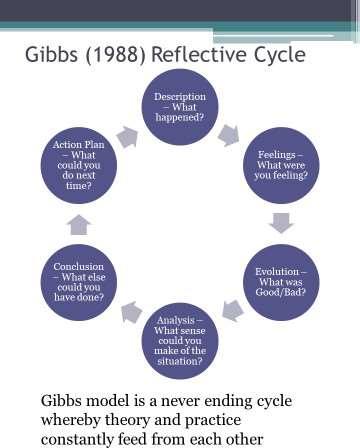
School of Business and Technology London, Copyright All Rights Reserved
Using Kolb’s reflective cycle allows you to plan ahead.By thinking back on how things progressed the last time around you are now in a position to plan your work better
• By starting off using basic reflective models you should progress to a deeper reflective process.
• The more you engage in reflection the deeper your learning experience becomes.
• You begin to use your own system for analysing tasks and can apply your learning to any task given instead of just similar tasks.
• In professional practice tasks do not always follow set procedures.
• You need to draw on both practical experience and theory to think on your feet and improvise.
• The Chartered Institute of Personnel and Development (CIPD) defines CPD as “the need for individuals to keep up to date with rapidly changing knowledge”
• A personal commitment from you to keep your knowledge up to date.
• Formal recording which shows commitment to your development of your career
School of Business and Technology London, Copyright All Rights Reserved
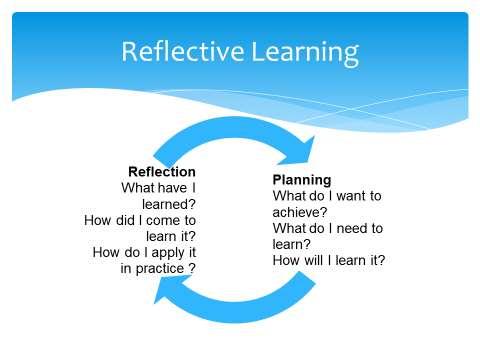
School of Business and Technology London, Copyright All Rights Reserved
• CPD is a personal record of your own experiences and training and development you have carried out There are many benefits to usingCPD, for example a tool for your CV and physical written record (we can’t remember everything!)
• “The credibility of the HR professional is based fundamentally on the commitment of individual members to continuing self –improvement” (CIPD, 2011)
• Ultimately, the outcome of reflection is learning (Meziros,1981).
• It widens our perspective on a problem (broadensknowledge)
• It helps us develop strategies for dealing with it (develop skills)
• It helps us acquire new insights into our behaviour (changes attitudes)
• K.S.A.
• Learning Burns (1995, p99) 'conceives of learning as a relatively permanentchange in behaviour with behaviour including both observable activity and internal processes such as thinking, attitudes and emotions.'
• The Three Types of Learning, (LearningDomains) Bloom, (1956):
• Cognitive: mental skills (Knowledge)
• Affective: growth in feelings or emotional areas (Attitude or self)
• Psychomotor:manual or physical skills (Skills)
School of Business and Technology London, Copyright All Rights Reserved
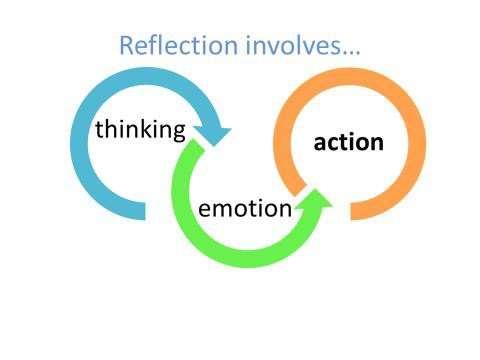
School of Business and Technology London, Copyright All Rights Reserved
• Attributes for reflection
• The key qualities (attitudes) individuals need to do proper reflection are:
• Open-mindedness
• Commitment to self-enquiry
• Motivation and
• Readiness to change practice
• Richardson & Maltby (1995), Gillings (2000)
• 3.3 & 3.4 as discovered as part of LO2 above, for coaching and mentoring to be most effective, they need to be embedded and aligned with the organisation’s culture, infrastructure,strategies and procedures.For this to happen it is imperativethat coaching and mentoring is supported by the senior management team so that coaching and mentoring has ‘legitimacy’ and recognition within the organisation.This also has a practical dimensionin terms of the resourcesand costs associated with it, and also, the ‘role modelling’ and cues given by senior management that supports integration with the organisation’s culture.
School of Business and Technology London, Copyright All Rights Reserved
• 3.7 & 3.8 these criteria are similarlylinked to LO2 above but demonstratethe ‘reverse’effect i.e. rather than organisationalculture impacting and influencing on coaching and mentoring, how coaching and mentoring impact and influence the organisational culture. An example is illustrated as follows: • Silo’ d working practices could be broken down through the use of coaching and mentoring due to the cross working and other practices it promotes such as communications, collaboration,relationshipbuilding, trust, respect, support, formalisinginformal networks,disseminatinggood practice, connectivity etc.
School of Business and Technology London, Copyright All Rights Reserved
• Definitions of Culture
• The unwritten beliefs, attitudes, values and expectations about how people work within the organisation ‘the way we do things around here’ Deal & Kennedy 1982
• ‘a body of learned behaviour, a collection of beliefs, habits and traditions, shared by a group of people and learned by people….’ Hofstede 1984
• ‘The collective programming of the mind’ Hofstede 1884
• “new recruits to an organisation learn the culture and must partially accept it or reject it and leave It is a powerful force which moulds and shapes behaviour of individuals but it is highly subjective and difficult to write down”
• The term ‘culture’ needs to define prior to defining the term ‘organisationalculture’. Culture is a set of values and beliefs that are usually upheld and followed by members of a community. Alvesson and Sveningsson (2015)
• Organisational culture could in the form of commoncode of conduct, perceptions, morality, ideas, preferenceand values. These values and beliefs are applicable in the organisational context that can be described as organisational culture. Driskill (2018)
• The beliefs and values followed and upheld by the members including employees can be described as organisationalculture. The behaviour of the members can be guided by an outstanding organisational culture. Organisational culture has the ability to knit the entire process of an organisation. Alvesson and Sveningsson (2015)
• In the organisational setting, culture consists of common norms, philosophies, attitudes, values, beliefs, ideologies, expectations and assumptions. Driskill (2018)
of Business and Technology London, Copyright All
Rights
School
Reserved
• Coaching and Mentoring Culture
• Clutterbuck and Megginson, in 'Making coaching work: creating a coaching culture', define a coaching culture as one where: Coaching is a predominant style of managing and working together, and where a commitment to grow the organisation is embedded in a parallel commitment to grow the people in the organisation.
• A key recommendation for mentoring schemes is that the relationships should be 'off-line' and cross functional (Clutterbuck & Megginson, 2005) and it is reasonable to assume that this recommendation should stand for internal coaching arrangements. ...
• .. Thus, the coach should make sure that the three-party contract is reasonably clear, agreed to by all, and sufficiently open, with objectives and deadlines not too narrowly defined. These initial steps suggest that the coach should encourage the organization to develop a coaching culture (Megginson and Clutterbuck, 2006), an environment in which coaching
•
School of Business and Technology London, Copyright All Rights Reserved
• embedded into the organization as an HR tool, rather than a short-term solution, engagingpeople both formally and informally, with col- leagues across functions and levels. As Megginson and Clutterbuck (2006)put it, Coaching … [should be] so seamlessly built into the structureof HR systems that [it occurs] automatically....
• ... These initial steps suggest that the coach should encourage the organization to develop a coaching culture (Megginson and Clutterbuck, 2006),an environment in which coaching is embedded into the organizationas an HR tool, rather than a short-term solution, engaging people both formally and informally, with col- leagues across functions and levels. As Megginson and Clutterbuck (2006)put it, Coaching … [should be] so seamlessly built into the structureof HR systems that [it occurs] automatically.The skills of learning dialogue are sufficiently widespread that people are able to raise difficult or controversialissues, knowing that their motivations will be respected and that colleagues will see it as an opportunity to improve, either personally, or organisationally, or both. ...
School of Business and Technology London, Copyright All Rights Reserved
• 10 Principles of Organizational Culture
• KATZENBACH, OELSCHLEGEL, THOMAS (2016)
• Work with and within your current cultural situations.
• Change behaviours, and mind-sets will follow
• Focus on a critical few behaviours.
• Deploy your authentic informal leaders.
• Don’t let your formal leaders off the hook.
• Link behaviours to business objectives.
• Demonstrate impact quickly
• Use cross-organizational methods to go viral.
• Align programmatic efforts with behaviours.
• Actively manage your cultural situation over time •
School of Business and Technology London, Copyright All Rights Reserved
Impact of organisational culture on coaching

Kim et al. (2014)
The coaching culture of an organisationexpands the scope and impactof the overall structure of an organisation.
Its impacts on the employees by boosting from top to bottom and creatively.
The organisation decides to coach employees to achieve peak performance. After providing coaching for employees, the organisation achieves the following things:
•Development of leadership pipeline
•Employee engagement
•Employee Retention at every level
•Development of skills at every level
•Increase in overall business performance
The key factors for achieving positive results in business are:
•Knowledge Management
•Optimal people performance
•A robust and aligned strategy
School of Business and Technology London, Copyright All Rights Reserved
• Importance of organisationalculture
• The various aspects which emphasise the importance of an organisation’s culture are:
• It helps in developing and promoting active and healthy relationships among the employees in the workplace.
• The culture of an organisation unites employees from different backgrounds
• It symbolises specific guidelines which help in guidingthe employees and provide logical direction at the workplace.
• It is the standardwhich decides the method used by employees to communicate amongthe team in the workplace.
• Organisationspossess the same culture and the way to maintaining and depicts organisation standard.
• Four CulturalNorms Support Constructive Cultures
• The four cultural norms that supportconstructive cultures are:
• Self-Actualising
• Affiliative
• Achievement
• Humanistic-Encouraging
School of Business and Technology London, Copyright All Rights Reserved
• Self-Actualising
• The organisation concentrates on enhancing self-actualising norms by encouraging the team members to make them think about the following:
• The most crucial aspect which makes the employee does work
• The new project the team has startedand the exciting fact in it
• The top development goal of an employee and the mode of achieving it for organisationalbenefits
• The method which helps in fulfilling goals effectively
• Chang et al. (2012)
• Affiliative
• The affiliative norms provide sensitive, cooperativeand friendly satisfactionfor work groupsof an organisation.
• The affiliative norms are enhanced by the following ways:
• The way of connection and cooperation between team members
• The level of satisfactionof members in a work groups
• The change that can be made in a team
School of Business and Technology London, Copyright All Rights Reserved
Achievement
•The coachingprocess of an organisation concentrates on achievement-related norms as it mainly focuses on the SMART goal setting.
•The SMART goals will help the leaders to become active role models and achieve and set goals for the broader development of the organisation.
•For encouragingachievement norms coaches consider various aspects and are:
•The maximum involvement of team members in setting up their own goals

•Actions and clear strategies supportthe developed goals
•The close connection of organisational priorities and goals with individual development goals
•The regularity in collecting feedback based on the progress for achieving the developed goals of an organisation
•Coaches help the leaders to overcome current weaknesses and issues and work for the development of the organisation.
School of Business and Technology London, Copyright All Rights Reserved
• Humanistic-Encouraging
• The coaching helps leaders of the organisation to understand the influences of different mental models.
• The mental models are considered as the underlying patterns of perceptions, emotions and thoughts which direct the actions and behaviour.
• Mental models will support, drive and serve the leader and can enter into the path of leaders and miss opportunities.
• It helps leaders to re-frame, understand, challenge and examine mental models.
• The various aspects considered for humanistic-encouraging are:
• The support level received for the leader in fulfilling his role
• The level of comfort of leaders in expressing the suggestions and ideas
• The fact which permits leaders to express their ideas and suggestions
• How the small change made by leaders bring a significant impact in improvising the sincerity among team
• Agbényiga (2011)
School of Business and Technology London, Copyright All Rights Reserved
Lessons Learned
Learned about an organisational culture and variousaspects related to it

Understood the various impacts of organisational culture on coaching
Studied briefly about the several impacts created by organisational culture on mentoring
Learned about the important cultural influences in the current period that may hinder coaching
Learned in deeply about the cultural influences in the current period that may hinder mentoring
Studied about the existing positive cultural influences on coaching
School of Business and Technology London, Copyright All Rights Reserved
Understood about the existing positive cultural influences on mentoring
• Cultural web model Mossop et al. (2013)
• In 1992, the cultural web model was introduced by Kevan Scholes and Gerry Johnson.
• Using the cultural web model, an organisation can analyse the prevailing culture. After the analysis, changes can be made if required to build a better culture.
• Cultural practices and assumptions can be unveiled using this model.
• Stories
• Rituals and Routines
• Symbols
• Organisational Structure
• Control Systems
• Power Structures
• Geert Hofstede 1983
• Dimensions of National Culture
• Organisational culture is strongly influenced by national ‘mores’.
Mossop et al. (2013)
• Mores Definition ‘Customs or conventions regarded as essential to or characteristicof a community’.
• American companies different from Japanese, British companies different from Continental ones
School of Business and Technology London, Copyright All Rights Reserved
• Organisational Culture & Nationality
• “……..collective mental programming; it is that part of our conditioning that we share with other members of our nation, region or group but not with members of other nations, regions or groups.” Hofstede, 1983
•
• Hofstede’s Six Dimensions
• Six dimensions of national culture which measures the differences in peoples work related values
• Power distance index (PDI)
• Individualism vs. collectivism (IDV)
• Uncertainty avoidance (UAI)

• Masculinity vs. femininity (MAS)
• Long-term orientation vs. short-term orientation (LTO)
• Indulgence vs. restraint (IND)
• An inclusive society, openness to change and innovation are the key characteristics of low UAI society. If a society is long term oriented, education, obligations and virtues are emphasised. Strong convictions can be seen in a short term oriented society. Minkov and Hofstede (2012)
School of Business Londo
• In the high MAS society, strong ego, money and accomplishments are given priority. Relationship oriented society and emphasis on quality of life are the important features of low MAS society. A society will be structured, rigid and conservative if the UAI is high. Migliore (2011)
• An inclusive society, openness to change and innovation are the key characteristics of low UAI society. If a society is long term oriented, education, obligations and virtues are emphasised. Strong convictions can be seen in a short term oriented society.
Minkov and Hofstede (2012)
• Freedom of speech, optimism and personal happiness could be seen in a high indulgence society. In a high restraint society, rigid and regulated behaviour and pessimism can be seen. Cronjé (2011)
School of Business and Technology London, Copyright All Rights Reserved
• Individualismversus collectivism
• Refers to the relation between an individual and their fellow individuals.
• In more individualistic societies everyone is supposed to look after their own self-interest and maybe, there close family.
• In a collectivist society,links between individuals are very tight. People are born into in-groups and are supposed to look after the in-groups interests.
• The degree of individualism is related to a country’s wealth.
• High correlation between low income and low individualism.( Pakistan, Peru, Portugal)
• Opposite end of the scale - USA, Canada, Denmark being individualistic
• UK has a high individualism index

• Germany has higher income but much lower individualism than the UK
• Power distance
• Concerned with society’s reaction to inequality. Some societies all inequalities in power and wealth to grow, others try to reduce them as much as possible.
• In organisations the level of power distance is related to the degree of centralisation of authority and the degree of autocratic leadership
• Power distance relates to how people relate to their superiors and subordinates. Where power distance is high superiors are far less accessible to subordinates thanwhere power distance is low.
• India, France, Belgium has a large power distance
School of Business and Technology London, Copyright All Rights Reserved
• UK, USA, Australia have a small power distance combined with high individualism
• All poor countries are collectivist with large power distance
• Uncertainty avoidance
• Concerns attitude to risk.
• Weak uncertainty avoidance communities
• Take risks easily, are more tolerant of behaviour and opinions different from their own, feel relatively secure
• Strong Uncertainty avoidance communities
• Show higher levels of anxiety and emotionality, create institutions to create security, have laws and rules which imply little tolerance of abnormal behaviour and opinions, have faith in technology and religions that claim absolute truth
• Japan , Latin America and Latin European countries have strong uncertainty avoidance and large power distance
• The UK and Sweden combine small power distance with medium to weak uncertainty avoidance.( shared solutions, initiative)
• Asian countries have large power distance with medium to weak uncertainty avoidance.(Family model, with a patriarchal authority figure
School of Business and Technology London, CopyrightAll Rights Reserved
• Masculinity versus femininity
• Concerned with social attitudes to the division of work between the sexes. What does society consider suitable work for women? What jobs should be offered to men?
• UK during there has been a considerable shift in opinion and attitudes. Equal Opportunities Commission cases by men, secretarial,domestic, nursing roles.
• In the UK , no gender bias.
• Japan, Germany, Austria , Switzerland are highly masculine.
• UK, India and the USA more moderate
• Scandinavians most feminine
• Long- Versus Short-TermOrientation
• This dimension was originally described as "Pragmatic Versus Normative (PRA)." Itrefers to the time horizon people in a society display. Countries with a long-term orientation tend to be pragmatic, modest, and more thrifty.
• In short-term oriented countries, people tend to place more emphasis on principles, consistency and truth, and are typically religious and nationalistic.
•
• Application: The U.S. has a short-term orientation. This is reflected in the importanceof short-term gains and quick results (profit and loss statements are quarterly, for example). It is also reflected in the country's strong sense of nationalism and social standards.
School of Business and Technology London, Copyright All Rights Reserved
•
•
Indulgence Versus Restraint
•
• Hofstede's sixth dimension, discovered and described together with Michael Minkov, is also relatively new, and is therefore accompanied by less data.
•
• Countries with a high IVR score allow or encourage relatively free gratification of people's own drives and emotions, such as enjoying life and having fun.
• In a society with a low IVR score, there is more emphasis on suppressinggratification and more regulation of people's conduct and behaviour, and there are stricter social norms.
•
Charles Handy4 Types of Corporate Culture
• The Power Culture
• influence & authority from a single source
• The Role Culture
• bureaucracy, rules, status = authority,
• The Task Culture
• focus on task, expertise, teams & matrix
• The Existential/Person Culture
• Individuals pursuing personal goals
https://www.trainingzone.co.uk/lead/culture/so-you-think-you-know-what-a-
coaching-culture-is
School of Business and Technology London, Copyright All Rights Reserved
• Huczynskiand Buchanan Culture
• OrganizationalCulture.The simple way of explaining culture is the way of how things are done in a business. According to Huczynski and Buchanan"an organization's culture focuses on the values, beliefs and meanings used by its members to grasphow its uniqueness originates, evolves and operates".
•
• Organizational Culture
• Organizationalculture encompasses values and behavioursthat contributeto the unique social and psychological environment of a business.The organizational culture influences the way people interact, the context within which knowledge is created, the resistance they will have towardscertain changes, and ultimately the way they share (or the way they do not share) knowledge. Organizationalculture represents the collective values, beliefs and principles of organizationalmembers. It may also be influenced by factorssuch as history, type of product, market, technology, strategy, type of employees, management style, and national culture. Cultureincludes the organization's vision, values, norms, systems, symbols, language, assumptions, environment, location, beliefs and habits.
• http://www.businessdictionary.com/definition/organizational-culture.html
School of Business and Technology London, Copyright All Rights Reserved
• The values and behavioursthat contributeto the unique social and psychological environment of an organization.
• Organizationalculture includes an organization'sexpectations,experiences, philosophy, and values that hold it together, and is expressed in its self-image, inner workings, interactions with the outside world, and future expectations. It is based on shared attitudes, beliefs, customs, and writtenand unwrittenrules that have been developed over time and are consideredvalid. Also called corporateculture, it's shown in
• (1) the ways the organization conducts its business, treats its employees, customers, and the wider community,
• (2) the extent to which freedom is allowed in decision making, developing new ideas, and personal expression,
• (3) how power and information flow through its hierarchy,and
• (4) how committedemployees are towards collective objectives.
•
• It affects the organization'sproductivityand performance,and provides guidelines on customer care and service, product quality and safety, attendanceand punctuality, and concern for the environment.
• It also extends to production-methods,marketing and advertising practices, and to new product creation.
Organizationalculture is unique for every organization and one of the hardest things to change.
School of Business and Technology London, Copyright All Rights Reserved
• Understanding Organisational Culture
• Interest in organisational culture began in the early '80s when management gurus such as Tom Peters began to focus on culture as a differentiator of successful organisations. In the past twentyodd years interest in culture has increased as case studies have identified a strong link between organisational culture and its performance.
• What is organisational culture?
• Organisational culture is the personality of the organisation, 'the way we do things around here'. Originally an anthropological term, culture refers to the underlying values, beliefs and codes of practice that make a business what it is.
•
• Management psychologistSchein describes culture as a phenomenon that surrounds us all. Culture according to Schein is 'A pattern of shared basic assumptions that a group learns as it solves problems'.
School of Business and Technology London, Copyright All Rights Reserved
• It can be seen through:
• 1. Behaviour: language, customs, traditions
• 2. Groups norms: standards and values
• 3. Espoused values: published, publicly announced values
• 4. Formal Philosophy: mission
• 5. Rules of the Game: rules to all in organizations
• 6. Climate: climate of group in interaction
• 7. Embedded skills
• 8. Habits of thinking, acting, paradigms: Shared knowledge for socialization
• 9. Shared meanings of the group
• 10. Metaphors or symbols
School of Business and Technology London, Copyright All Rights Reserved
• Influences on Culture
• The culture of an organisation is influenced and shaped by
• National mores
• The environment of the organisation

• The nature and purpose of the organisation
• The history and stage of development
• The values and beliefs of the people
• The management style
• The structure of the organisation
School of Business and Technology London, Copyright All Rights Reserved
• Why is culture important?
• Evidence shows that organisations who have strong cultures are capable of increasing revenue, profitability and shareholder value. Likewise organisations with weak cultures find it difficult to change and adapt to market demands. Many ex-monopolies in the public sector for example struggled to respond to changing consumer patterns. In the early 1990s IBM recognised that it needed to fundamentally change its culture and self-belief that it was invincible in the marketplace. Its then somewhat arrogant culture had prevented it from recognising the rise in demand for personal computers and it was in danger of failure as a company.
• With the growing increase in globalisation, organisations face far more competition than ever before. Having a strong culture which supports and underpins an organisation's brand proposition helps businesses create and maintain competitive advantage - witness organisations such as Sony, Disney and Orange.
• Increasingly business leaders are recognising that the concept of organisational culture is particularly important when it comes to managing organisation-wide change. If change is to be deep seated and long lasting within an organisation, it needs to happen at a cultural level. The challenge for many organisations is how to change existing cultures as culture is rooted deep in the unconscious but represented in behaviour and practice.
School of Business and Technology London, Copyright All Rights Reserved
• Different types of culture
• The best way to begin a culture change process is to better understand the culture in which you are currently operating. If you don't understand and manage culture, it will manage you.
• There are a number of different types of culture, just like there are many different personalities. Here is a selection of theories of culture types:
• Charles Handy points out that there are three cultural types:
• Power cultures with a single power source. This may be an individual or a group who typically controls via a web of communications how people are rewarded.
• Task cultures based on flexible matrix structures preserve a strong sense of purpose and promote teamwork.
• Role cultures which predominate typically pyramid structures and where hierarchy and regulation abound.
School of Business and Technology London, Copyright All Rights Reserved
• Jeffrey Sonnenfeld identified the following four cultural types:
• • Academy culture typified by stable environments such as hospitals, universities, large corporationswhere employees are highly skilled and tend to stay with the organisation.
• • Club culture typified by military organisationswhere employees work their way up the organisation.There is a strongsense of fit with the group and organisations promote from within, valuing seniority
• • Fortress culture where specialised skills are promoted and where organisations respond to market needs by downsizing or reorganising for example in financial services and car manufacturers
• • Baseball team culture where employees are 'stars' with skills that allow them to readily transfer from one firm to another e.g. advertising agencies, investment banking
• In his book, The Chameleon Consultant (Gower Publishing2002 ISBN 0 566 08407 4), Andrew Holmes develops a model of four generic types of culture:
• • High Sociability, LowSolidarity = Networked culture
• • High Sociability, HIgh Solidarity = Communal culture
• • Low Sociability, LowSolidarity = Fragmented culture
• • Low Sociability, High Solidarity = Mercenary culture
School of Business and Technology London, Copyright All Rights Reserved
• Methods for analysing organisationalculture, Johnson and Scholes Cultural Web
• One way to understand culture is to use an analytical framework. Johnson and Scholes call their framework the Culture Web, a series of overlapping aspects of culture which make up the collective mind-set. The Culture Web is best considered individually and then discussed with groups of managers. For example, look at your own organization in relation to the following:
• Symbols - logos, offices, cars
• Power - who has power
• Organizational Structure - formal and informal structures
• Controls - what gets measured and rewarded
• Rituals - what are accepted procedures and rituals
• Stories - sometimes called 'war stories'
School of Business and Technology London, Copyright All Rights Reserved
• Changing Culture
• There is a growing trend as identified above for culture change to be promoted to bring about greater organisational effectiveness. Most management gurus recognise that changing culture is a long-term project. It takes between three and five years. It is a process that can be undertaken bottom up but ultimately very much depends on the leadership of the organisation. This group shapes and reinforces the way that the organisation functions.
• It is generally accepted that to bring about culture change, all aspects of the organisation need to change.
School of Business and Technology London, Copyright All Rights Reserved
• Mckinsey 7 'S' framework
• The 7 'S's diagnostic framework, developed by management consultants McKinsey, provides a useful perspective with which to assess the culture and effectiveness of an organization.The Seven 'S's are:
• 1 Structure
• 2 Strategy
• 3 Shared values
• 4 Style
• 5 Staff
• 6 Skills
• 7 Systems
School of Business and Technology London, Copyright All Rights Reserved
• 1. Structure
• There are many permutations of structure that an organization can adopt:
• • Centralised
• • Decentralised

• • Hierarchical
• • Flat
• • Team based
• • Virtual
• Each has its pros and cons. For example many layers of hierarchy can block a leader's access to customers and vice versa. Middle managers may 'filter' reality and present leaders with the picture of customer satisfaction which they wish them to see. The result of this is not only leaders who lack customer focus, but also employees who are fearful of 'stepping out of line' or taking responsibility for the customer.
School of Business Londo
• 2. Strategy
• The strategy of an organization shapes its structure. Likewise the behaviours and values of an organization can promote or undermine its strategy
• 3. Shared values
• If you discover the passion of the CEO, you will discover the organizations real priorities. Is there fundamental passion towards – making money?- staff relationships?- customer orientation?
• These are important issues to get to the bottom of. What measures are used in reward systems? This often shows the reality of what is important to the organization
School of Business and Technology London, Copyright All Rights Reserved
• 4. Style
• How leaders behave influences the behavioursof their staff. The most effective leaders are those who are sensitive to people's needs. When senior managers? career paths havebeen via specialist or technical functions, for example, they may well fail to appreciatethe need for a holistic approachto change. Typically where this style prevails, quantitativemeasures are set for operationaldelivery. Little attentionis paid to the qualitativeaspects of service such as creating rapport and being empathetic to the customer.
• Senior managers are often pre-occupied with other influences such as competitors, shareholders,the City, government and regulatory bodies. Customers compete against these other preoccupations for their share of airtime and often lose.
• Senior managers can all too easily become cocooned in a world far removed from the customer and the company people who work at the sharp end. One acid test of how removed your senior people may be from customers is: Who replies when a customer writes to the CEO?
School of Business and Technology London, Copyright All Rights Reserved
We are increasingly engaged within organizations to move front-line employees from a dependent, compliant and rulebound style towards one where they freely take risks and confidently exercise discretion. The answer frequently starts with the very senior managers who bemoan the lack of initiative in their staff. People working for 'task-master' style managers who are directive and autocratic develop into terrorists - reluctant or resistant to change, or spectators - who take a back seat when it comes to resolving a customer problem. This is because people often become resentful or discouraged to take initiative when they are constantly told what to do and when the only feedback they receive is negative. New recruits soak up culture like sponges: they may have been recruited for their winning qualities, but they are influenced strongly by other's behaviours.
• This remoteness frequently leads managers to:
• • Become hooked into the internal politics of the organization
• • Shut off from honest feedback

Rarely see the customer face-to-face
• This can all add up to management decisions which are far from customer-friendly such as rules and regulations that work well for the organization but not the customer.
School of Business Londo
4. Staff
•
•
• 6. Skills
• Customer orientated organizations such as the department store Nordstrom in the US emphasize the attitude and interpersonal skills needed to interact effectively with customers. Role, skills and knowledge can be taught, whereas many of the less tangible, empathetic interpersonal skills involve being able to create vital rapport with customers. Nordstrom recruit only self-starters - a high commission system helps deselect others. Each of Nordstrom's 35,000 staff effectively runs their own business (within limited rules).
• 7. Systems
• The systems, which organizations use to interact with their customers, need to be designed with the customer in mind.
• Conclusions
• • Organisational culture is the glue that holds the organisation together.
• • Culture is important as a strong culture has proven to underpin high performance
• • There are many different types of culture which can exist even within the same organisation
• • Questionnaires, audits, card sort techniques and rich pictures are methods for diagnosing organisational culture
• • Changing organisational culture requires a long term approach ? it involves reassessing and making changes to all aspects of the organisation
School of Business and Technology London, Copyright All Rights Reserved
• Sarah Cook, Stairway Consultancy Ltd, www.thestairway.co.uk (2019)
• Organisational culture Characteristics
• Stability
• Innovation
• Teamwork
• Attention to detail
• Aggressiveness
• Emphasis on outcome and people
• Alvesson and Sveningsson (2015)
• What is Coaching Culture Parsloe (2016)
• In a coaching culture, most staff use a coaching approach in their daily life – with each another, and with external stakeholders and customers. A true coaching culture is just ‘part of the way we do things around here’. But it’s not all motherhood and apple pie. A coaching culture is about delivering results, improving performance and making the most of people’s potential. The emphasis is on delivering results and making each other (and the wider organisation) stronger and more capable. It’s NOT about having coaching conversations for their own sake, or as a diversion from other activities!
School of Business and Technology London, Copyright All Rights Reserved
• If you could be a ‘fly on the wall’ in a coaching culture, here’s what you’d see:
•
• Managers looking for opportunities to help others to learn
• People asking each other open questions
• Employees at all levels having open, honest and supportive conversations with one another
• People routinely giving one another feedback - supportive and critical
• Managers coaching team members to help them develop, rather than just to tackle poor performance
• Coaching and mentoring relationships forming spontaneously
• Senior leaders with a clear vision that coaching and mentoring are at the heart of how we operate
• Teams working with clear goals, roles, processes and relationships
• Relatively few people will be ‘playing politics’
• A pragmatic focus on delivering results and at the same time building the long-term health of the business
Parsloe (2016)
https://www.koganpage.com/article/what-is-a-coaching-culture
School of Business and Technology London, Copyright All Rights Reserved
• Creatinga Coaching Culture CIPD
• • What is the organisation'sstrategy?
• • How does the organisation position itself?
• • What priorities does the organisation have?
• • Who supports coaching and mentoring?
• Coaching Culture
• A coaching culture simply means supporting your employees so that they learn new skills and become greater assets to the company. A management culture that emphasizes training, regular feedback, and opportunities for growth creates a more engaged and energized workforce.
• The benefits of a coaching culture. ... Coaching in the workplace improves leadershipdevelopment. It also improves employee engagement, communicationskills and teamwork in the company. Businesses that value the importance of coaching have seen significant resultsin employee engagement and financial productivity.
School of Business and Technology London, Copyright All Rights Reserved
• What is a Coaching Culture? Parsloe (2016)
• If you could be a ‘fly on the wall’ in a coaching culture, here’s what you’d see:
• Managers looking for opportunities to help others to learn
• People asking each other open questions
• Employees at all levels having open, honest and supportive conversations with one another
• People routinely giving one another feedback - supportive and critical
• Managers coaching team members to help them develop, rather than just to tackle poor performance
• Coaching and mentoring relationships forming spontaneously
• Senior leaders with a clear vision that coaching and mentoring are at the heart of how we operate
• Teams working with clear goals, roles, processes and relationships
• Relatively few people will be ‘playing politics’
• A pragmatic focus on delivering results and at the same time building the long-term health of the business
• School of Business and Technology London, Copyright All Rights Reserved
• How to createa “coaching culture” Parsloe(2016)
• The first step is to create clear vision for the culture. It doesn’t have to be a perfect picture but it does need to be inspiring! How will the culture help you deliver the strategy? What’s in it for leaders – and for all employees? How will it benefit your customers/ shareholders?
• It’s also important to know where you’re coming from. You can conduct a ‘readiness audit’ to find out how much coaching and mentoring are already happening in your organisation. And how receptive people are to doing things differently.
• And it’s important to have some first steps. In the early stages of creating a coaching culture, there’s often more reliance on external coaches and external support. But this reliance soon drops away as you train a cohort of internal coaches and/or mentors – as well as leaders who use a coaching approach in their daily lives. This trickles down to how employees treat each other.
• Creating a coaching culture takes time but doesn’t alwaystake a lot of investment if it’s done in a savvy way. Parsloe (2016) https://www.koganpage.com/article/what-is-a-coaching-culture
School of Business and Technology London, Copyright All Rights Reserved
• Creating a Coaching Culture Bishop (2018)
• “Creating a coaching culture at work has several benefits for you and your employees. Staff are given development opportunities and therefore likely to feel more valued and motivated. In turn, the business can mitigate the risk of high staff turnover and save money on recruitment by encouraging progression and promoting from within” Bishop (2018)
• Top employee desires in the workplace are:
• To feel appreciated and valued
• To gain a deeper understanding of their role in the business
• To feel a deeper social connection to their colleagues
• To achieve a greater work life balance
• The top benefits to a vibrant and constantly evolving coaching culture in the workplace are:
• Improving employees sense of purpose
• Boosting morale and employee motivation
• Increasing productivity through skill development
• Improving internal communication and rapport across the business
• Improving employee engagement
• Improving employee wellbeing
• Reducing the need to recruit externally for senior roles
• Reducing employee turnover
School of Business and Technology London, Copyright All Rights Reserved
•
Schein Definition of Culture
• Schein describes two very different organisations:
• Organisation A
•
Operates on the assumption that:
•
• Ideas comes ultimately from individuals
• People are responsible, motivated and capable of governing themselves
•
• • Nevertheless, in practice, truth can only be arrived at by fighting things out in groups
• • Such fighting is possible because members of the organisation see themselves as a family who will take care of each other.
School of Business and Technology London, Copyright All Rights Reserved
• It is therefore safe to fight and be competitive
• Characteristics:
• • Open office landscapes
• • Few closed doors
• • People milling about
• • Intense organisations and arguments
• • A general air of informality Organisation B Operates on the assumption that:
• Truth comes ultimately from older, wiser and higher status members
• People are capable of loyalty and discipline in carrying out directions
• Relationshipsare basically lineal and vertical
• Each person has a niche in the organisation that cannot be invaded
• The organisation
Sicshoroe l sop f BounsinseibsslLeonfd oorn,tCaopykirnigghtcAa llrReighotsfRie tsserm vee d mbers.
• Characteristics:
• • Hush in the air
• • Everyone in an office with closed doors
• • Nothing is done except by appointment and prearranged agenda
• • If people of different ranks are present there is real deference and obedience
• • An air of formality permeates everything
•
• Neither organisation is wrong – they are just different .From Schein, “Coming to a New Awareness of Organisational Culture”, Sloan Management Review, (1984)
•
• On the Coevolution of Stereotype, Culture, and Social Relationships: An Agent-Based Model
• Kenneth Joseph, Geoffrey P. Morgan, Michael K. Martin , Kathleen M. Carley (2014)
School of Business and Technology London, Copyright All Rights Reserved
• Constructuralism
• The theory of constructuralism describes how shared knowledge, representative of cultural forms, develops between individuals through social interaction.
• Constructuralism argues that through interaction and individual learning, the social network (who interacts with whom) and the knowledge network (who knows what) coevolve.In the present work, we extend the theory of constructuralism and implement this extension in an agent-based model (ABM).
School of Business and Technology London, Copyright All Rights Reserved
Our work focuses on the theory's inability to describe how people form and utilize stereotypes of higher order social structures, in particular observable social groups and society as a whole. In our ABM, we formalize this theoretical extension by creating agents that construct, adapt, and utilize social stereotypes of individuals, social groups, and society. We then use this model to carry out a virtual experiment that explores how ethnocentric stereotypes and the underlying distribution of culture in an artificial society interact to produce varying levels of social relationships across social groups. In general, we find that neither stereotypes nor the form of underlying cultural structures alone are sufficient to explain the extent of social relationships across social groups. Rather, we provide evidence that shared culture, social relations, and group stereotypes all intermingle to produce macrosocial structure.
https://pdfs.semanticscholar.org/e91b/8eaca0b540bde7874590b6c0b68b82270140.pdf?_ga=2.3412
6561.131983155.1579171737-2010265328.1579171737
School of Business and Technology London, Copyright All Rights Reserved




















